Istanbul Top 10 Mosques: Istanbul’s mosques echo the city’s rich and layered history, reflecting its evolution from a Byzantine capital to an Ottoman imperial centre. Hagia Sophia, originally a Byzantine cathedral, is the prime example of this transformation. Its conversion to a mosque in 1453 marked a pivotal moment in the city’s narrative. Numerous grand mosques were constructed following the Ottoman conquest, showcasing the empire’s architectural prowess and devotion. The Sultan Ahmed Mosque (Blue Mosque), the Süleymaniye Mosque, and the Fatih Mosque, among others, exemplify the classical Ottoman style, characterised by their soaring domes, graceful minarets, and intricate tilework. These structures were not merely places of worship but also complex social and educational centres, often surrounded by charitable institutions, schools, and libraries.
A harmonious blend of grandeur and spirituality defines the character of Istanbul’s mosques. Their interiors, adorned with vibrant İznik tiles, calligraphic inscriptions, and stained-glass windows, create an atmosphere of serene contemplation. The interplay of light and shadow within these spaces evokes a sense of awe and reverence. Beyond their architectural beauty, these mosques serve as vital community hubs where people gather for prayer, reflection, and social interaction. They are integral to Istanbul’s identity, embodying its cultural heritage and enduring religious traditions. According to the Turkish Statistical Institute (TÜİK), as of 2024, there are 3,555 mosques in Istanbul and 89,817 across Türkiye. The monumental imperial mosques and smaller neighbourhood sanctuaries contribute to the city’s spiritual and architectural landscape.
Istanbul Top 10 Mosques – Table of Contents
Istanbul Top 10 Mosques
Hagia Sophia Grand Mosque (537, converted 1453)
Location: Ayasofya-i Kebir Cami-i Şerifi, Sultan Ahmet, Ayasofya Meydanı No:1, 34122 Fatih/İstanbul. The official site website link (Turkish only) and the official Turkish Museums website. Opening Hours: Daily: 09:00 – 19:30. On Friday, the Hagia Sophia is typically closed for noon prayers from 12:30 until 14:30. Entrance Fee: The full-price adult (over 8 years old) entrance fee in February 2025 was €25.00.
Notes on Entrance: As of January 2024, Hagia Sophia has two entrances. The one on Sultanahmet Square is now exclusively for Turkish citizens visiting the worship area in the former narthex and nave. To better manage the over-tourism and visitor flow and preserve Hagia Sophia’s sanctity as a functioning mosque, new rules have been implemented, primarily separating tourist visits from prayer. Tourists now enter on the northeast side near the Fountain of Sultan Ahmet III through a designated entrance to the upper-level galleries. At the same time, the ground floor is reserved for worshippers. This separation, along with introducing an entrance fee for tourists, aims to reduce crowding, maintain a respectful atmosphere for those praying, and aid in preserving this historical and religious site. Women visitors must also wear a headscarf before they enter the upper gallery.
Commissioned by Byzantine Emperor Justinian and consecrated in 537 as a Christian basilica, Hagia Sophia stood as the pinnacle of Byzantine architectural achievement for nearly a millennium. Its magnificent dome, a marvel of engineering for its time, and its intricate mosaics spoke to the grandeur of the Byzantine Empire. Following the Ottoman conquest of Constantinople in 1453, Hagia Sophia was converted into a mosque, adding minarets and Islamic calligraphic inscriptions, reflecting the new rulers’ faith. After establishing the Turkish Republic as part of his secularisation policy agenda, founding President Atatürk turned Hagia Sophia into a museum in 1935. 85 years later, President Erdoğan ordered that the Hagia Sophia be reconverted into a mosque, “Ayasofya-i Kebir Cami-i Şerifi,” which opened for prayers on 24 July 2020.
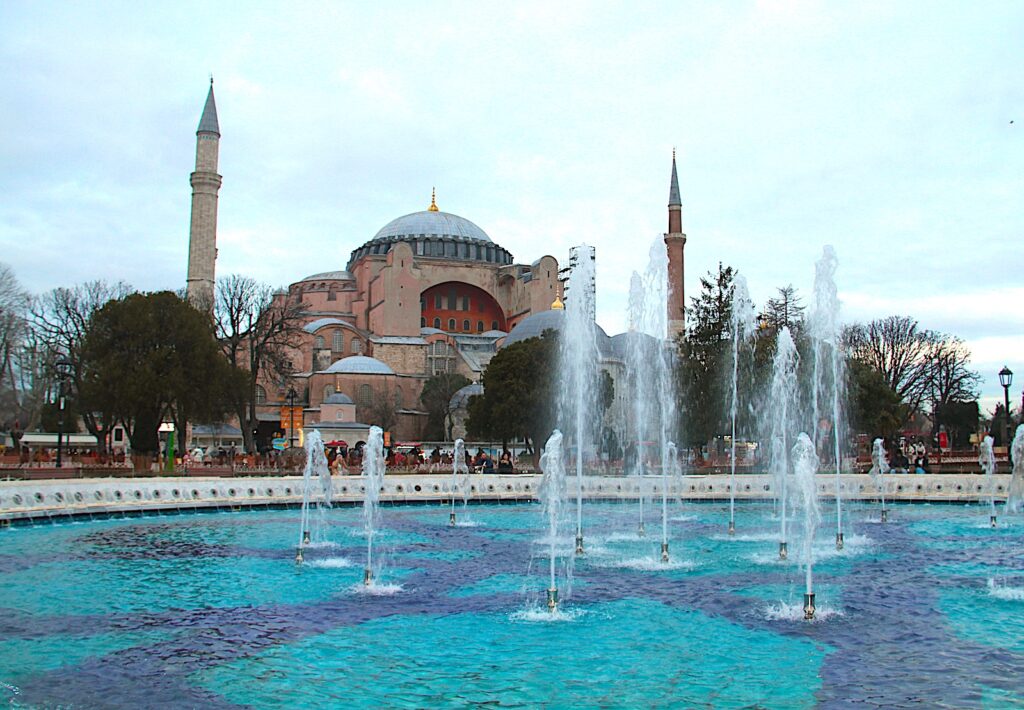
The architectural features of Hagia Sophia are genuinely breathtaking. Its most iconic element is the massive central dome, which creates a sense of awe-inspiring space. Using pendentives to support the dome was a revolutionary engineering technique, allowing for a seamless transition from the square base to the circular dome. The building has exquisite marble columns, intricate mosaics, and vast open spaces. These elements combine to create a sense of both grandeur and spiritual reverence. Blending Byzantine and Ottoman architectural styles further enhances the building’s unique character. The visible signs of Christianity and Islam within the building powerfully remind visitors of its complex past. Hagia Sophia’s sheer scale, rich history, and artistic treasures make it a remarkable and significant landmark. It is a place where history, art, and faith converge, offering visitors a glimpse into the past and a sense of wonder.
To maximise your Hagia Sophia experience, aim for weekday early mornings, such as Tuesdays or Wednesdays, avoiding Fridays due to noon prayers to ensure entry. During the spring or autumn, shoulder seasons to avoid peak crowds and enjoy pleasant weather. Under the rules implemented in January 2024, professional guides can no longer give tours inside the Hagia Sophia. Instead, visitors can scan a QR code on their phone (or rent headsets) to access an audio-visual tour. The tour offers details on 10 points of interest in over 20 languages.
Sultanahmed Mosque – Blue Mosque (1616)
Location: Sultanahmet Camii, Binbirdirek, At Meydanı Cd No:10, 34122 Fatih/İstanbul. The official site website link (English. Opening Hours: Daily: 09:00 – 18:00 (The mosque closes to non-worshippers during the five daily prayer times). Entrance Fee: As of February 2025, entry to the mosque is free.
Notes on entry: Unlike Hagia Sophia, entry to the Sultanahmet Mosque is free. However, visitors must adhere to strict rules: respectful attire is mandatory, meaning both men and women must cover their shoulders and knees, and women must also cover their hair with a scarf. Visitors must remove their shoes before entering, and entry is prohibited during prayer times. Photography is generally allowed, but visitors should be mindful and avoid disrupting worshippers. Security checks are in place, which can result in wait times, especially during peak tourist seasons.
The Sultanahmet Mosque, more commonly known as the Blue Mosque, was constructed between 1609 and 1616 during the reign of Sultan Ahmed I. He commissioned it as a grand imperial mosque to rival the Hagia Sophia. Its construction was a period of relative peace for the Ottoman Empire, and the sultan aimed to create a lasting architectural masterpiece. The mosque’s design blends traditional Islamic architecture with Byzantine elements, showcasing the historical and cultural influences that shaped Istanbul. The location was carefully chosen, placing it near the Hagia Sophia and the Hippodrome, creating a powerful visual statement of Ottoman imperial power.

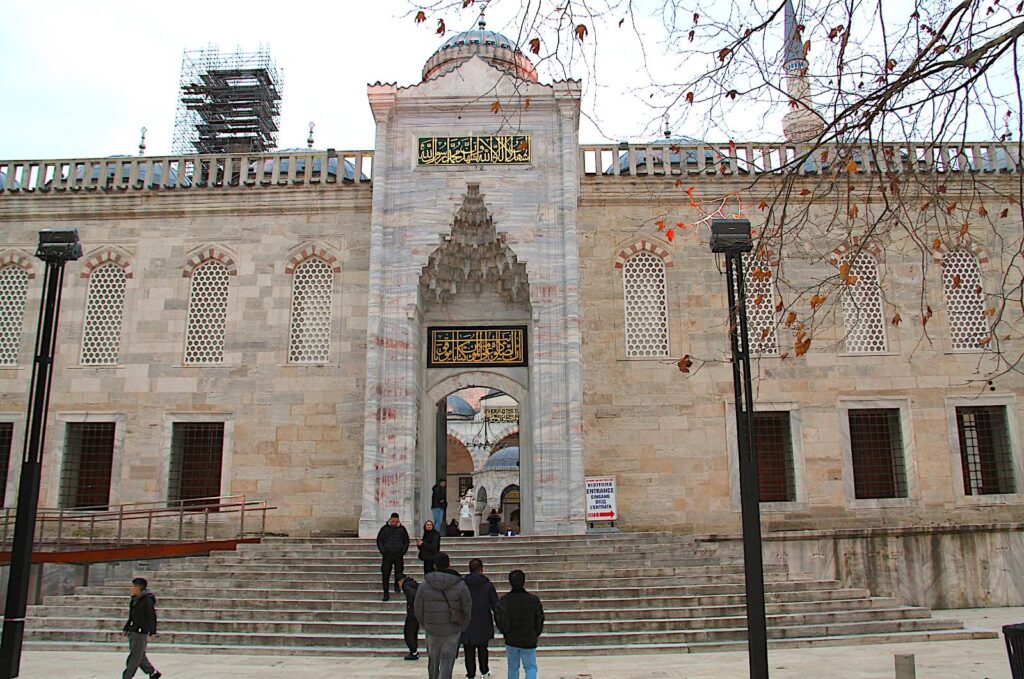

The mosque’s most striking feature is its six minarets, a rare architectural element that initially caused controversy as it was equal to the number of minarets at the Kaaba in Mecca. To resolve this, a seventh minaret was later added to the Kaaba. The Blue Mosque’s interior is adorned with over 20,000 handmade İznik tiles, predominantly blue, which give the mosque its popular name. These tiles feature traditional floral and geometric patterns, creating a mesmerizing visual effect. The central dome, supported by four massive pillars, rises to 43 meters, creating a vast, awe-inspiring space. The mosque’s numerous windows allow natural light to flood the interior, illuminating the intricate tilework and creating a serene atmosphere.
Beyond its architectural beauty, the Blue Mosque serves as a functioning place of worship, maintaining its religious significance. It also stands as a testament to the Ottoman Empire’s artistic and engineering prowess. The mosque’s courtyard, with its ablution facilities and surrounding arcades, provides a peaceful space for contemplation and prayer. Its location within the heart of Istanbul’s historical peninsula makes it a central landmark and a symbol of the city’s rich cultural heritage. The Blue Mosque attracts visitors worldwide, offering a glimpse into the grandeur of Ottoman architecture and the enduring legacy of Islamic art.
Süleymaniye Mosque (1557)
Location: Süleymaniye Camii, Süleymaniye, Prof. Sıddık Sami Onar Cd. No:1, 34116 Fatih/İstanbul. The official Fatih District site website link (Turkish). Opening Hours: Saturday to Thursday: 08:30 – 16:45, Friday 08:30-13:30. Entrance Fee: Entry to the mosque is free.
The Süleymaniye Mosque, a magnificent Ottoman imperial mosque, graces the Third Hill of Istanbul. It was commissioned by Süleyman the Magnificent, one of the Ottoman Empire’s most powerful rulers, and masterfully designed by the renowned imperial architect Mimar Sinan. Construction spanned from 1550 to 1557 and is part of a larger külliye, a complex that includes a hospital, public kitchens, schools, and a bathhouse.
Architecturally, the Süleymaniye Mosque is distinguished by its impressive central dome, which reaches a height of 53 meters, and its four elegant minarets. Mimar Sinan’s design showcases a harmonious blend of Ottoman and Islamic architectural styles, with a spacious and luminous interior adorned with intricate details. The mosque’s design showed Sultan Süleyman’s desire to exceed the Hagia Sophia. The mosque holds significant importance as a place of worship and as the final resting place of Sultan Süleyman and his wife, Roxelana, whose tombs are located within the mosque’s complex.
Fatih Mosque (1470, reconstructed 1771)
Location: Fatih Camii, Ali Kuşçu, Hattat Nafiz Caddesi No:6, 34083 Fatih/İstanbul. The official site website link (Turklish). Opening Hours: Daily: As a working mosque, there are no set opening hours. Entrance Fee: Entry to the mosque is free.
The Fatih Mosque, meaning “Conqueror’s Mosque,” is significant in Istanbul’s history. It was originally commissioned by Mehmed the Conqueror (Fatih Sultan Mehmed) and initially designed by the architect Atik Sinan. Construction of the original complex began in 1463 and was completed in 1470. However, the original mosque suffered severe earthquake damage, particularly in 1766, leading to its reconstruction. Today’s mosque was rebuilt in a Baroque style under Sultan Mustafa III, with architect Mimar Mehmet Tahir overseeing the project.
Architecturally, the Fatih Mosque displays a blend of historical influences. While the original structure incorporated elements of earlier Ottoman design, the current mosque reflects 18th-century Baroque architecture. A prominent feature is its central dome, supported by four semi-domes. The complex, or külliye, originally included numerous supporting structures like medreses (religious schools), a hospital, and a public kitchen, highlighting its role as a social and religious centre. The mosque also holds spiritual significance as the burial site of Mehmed the Conqueror, whose tomb is located within the complex.
Rüstem Pasha Mosque (1563)
Location: Rüstem Paşa Camii, Rüstem Paşa, Hasırcılar Cd. No:62, 34116 Fatih/İstanbul. No official website. Opening Hours: Daily: 06:00 – 21:30. Entrance Fee: Entry to the mosque is free.
The Rüstem Pasha Mosque, a hidden gem within Istanbul’s bustling landscape, was commissioned by Rüstem Pasha, Grand Vizier, to Süleyman the Magnificent and his son-in-law. The celebrated Ottoman architect Mimar Sinan designed the mosque, and construction was completed around 1563. This mosque, though relatively small, is renowned for its exceptional and profuse use of İznik tiles, making it a masterpiece of Ottoman ceramic art.
A unique architectural feature of the Rüstem Pasha Mosque is its elevated position, built atop a series of shops, which provides a raised platform for the structure. This design decision was likely made to maximise the use of space in the dense commercial area. The interior is a visual spectacle, with walls, the mihrab, and the minbar lavishly adorned with intricate İznik tiles displaying a wide array of floral and geometric patterns. This abundance of high-quality tiles is its defining characteristic and a key factor in its religious and artistic significance.
Şehzade Mosque (1548)
Location: Şehzade Cami, Kalenderhane, 34134 Fatih/İstanbul. The official Fatih District website link (Turkish). Opening Hours: Daily: As a working mosque, there are no set opening hours. Entrance Fee: Entry to the mosque is free.
The Şehzade Mosque, also known as the “Prince’s Mosque,” is a 16th-century Ottoman imperial mosque in the Fatih district of Istanbul. It was commissioned by Süleyman the Magnificent as a memorial to his beloved son, Şehzade Mehmed, who died in 1543. The mosque is one of the earliest and most significant works of the renowned Ottoman architect Mimar Sinan, marking a pivotal point in his career. It was constructed between 1543 and 1548.
Architecturally, the Şehzade Mosque is celebrated for its symmetrical design and harmonious proportions. A defining feature is its central dome, which is surrounded by four semi-domes, creating a visually balanced and impressive structure. The mosque’s courtyard, with its elegant porticoes, adds to the overall sense of tranquillity and grandeur. The two minarets, each with two balconies, are also notable for their detailed decorative work. The complex surrounding the mosque, known as a külliye, includes tombs, a madrasa (religious school), and other supporting structures, highlighting its role as a spiritual and social centre.
Beyazıt Mosque (1506)
Location: Beyazıt Camii, Beyazıt, Yeniçeriler Cd., 34126 Fatih/İstanbul. The official Fatih District website link (Turkish). Opening Hours: Daily: As a working mosque, there are no set opening hours. Entrance Fee: Entry to the mosque is free.
The Beyazıt Mosque, located in the historic centre of Istanbul near the Grand Bazaar, is one of the oldest surviving imperial mosques of the Ottoman Empire. Commissioned by Sultan Bayezid II, the son of Mehmed the Conqueror, the mosque was constructed between 1501 and 1506. It was built on the site of the ancient Forum of Theodosius, integrating the legacy of Byzantine Constantinople into the emerging Ottoman capital. The mosque formed the heart of a large külliye (religious complex), which included a soup kitchen, medrese (Islamic school), hammam, caravanserai, and a library, reflecting the Ottoman emphasis on both civic and spiritual service. The mosque also served as a dynastic symbol of legitimacy during the early years of the empire’s consolidation in Istanbul.
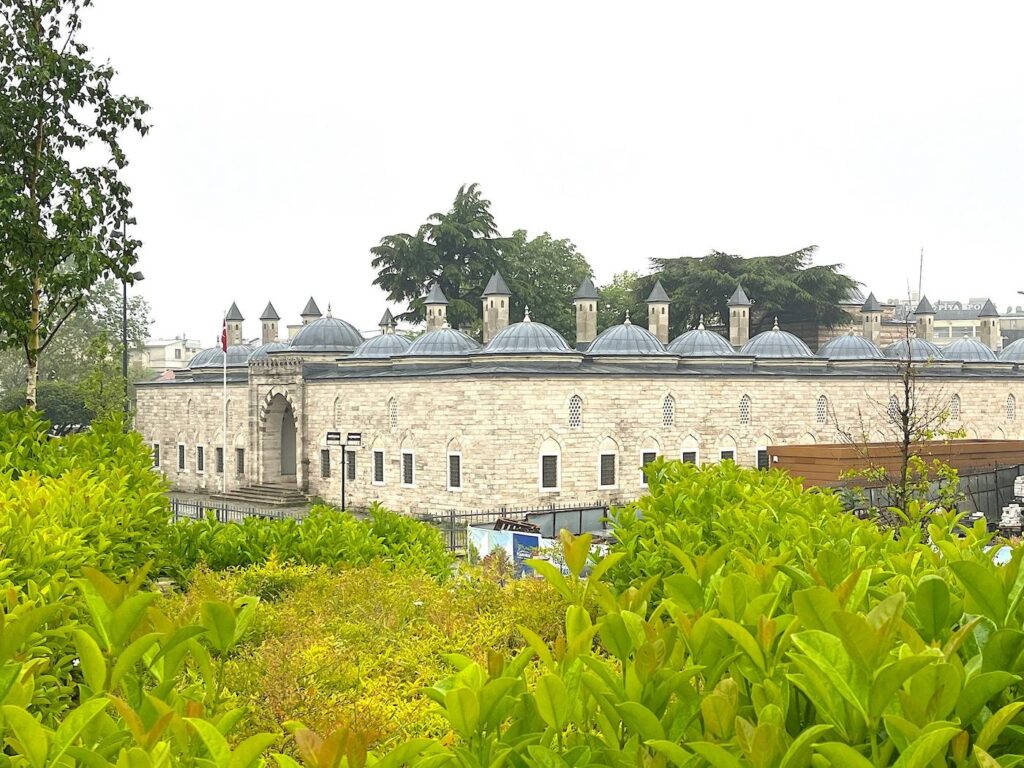

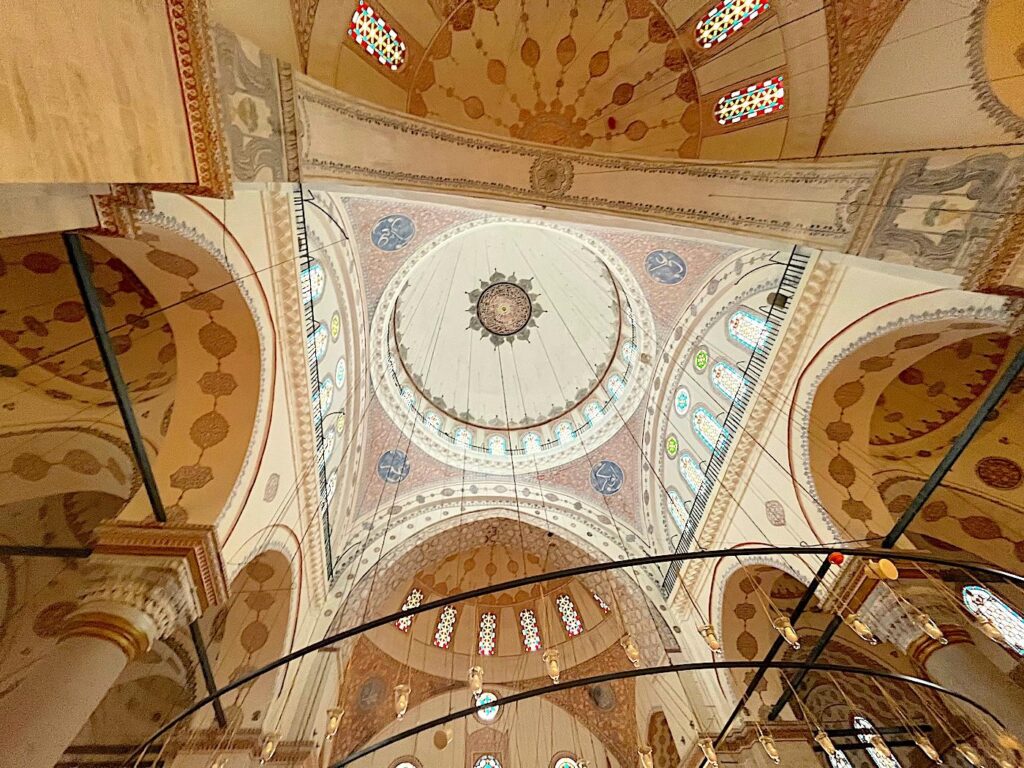
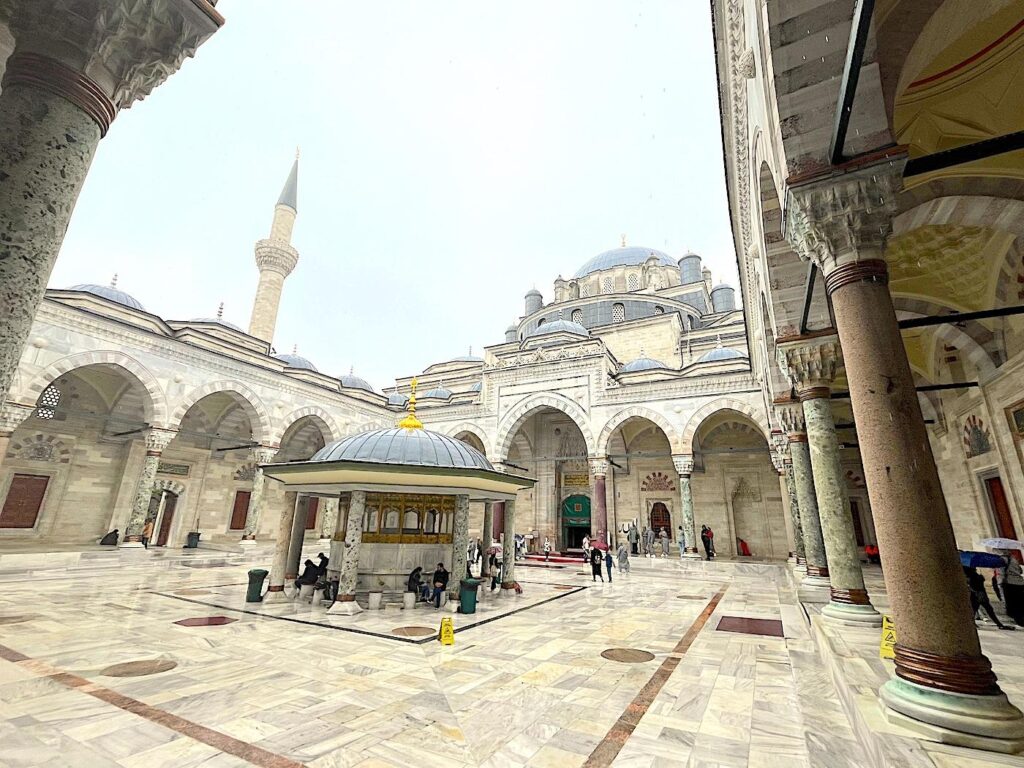
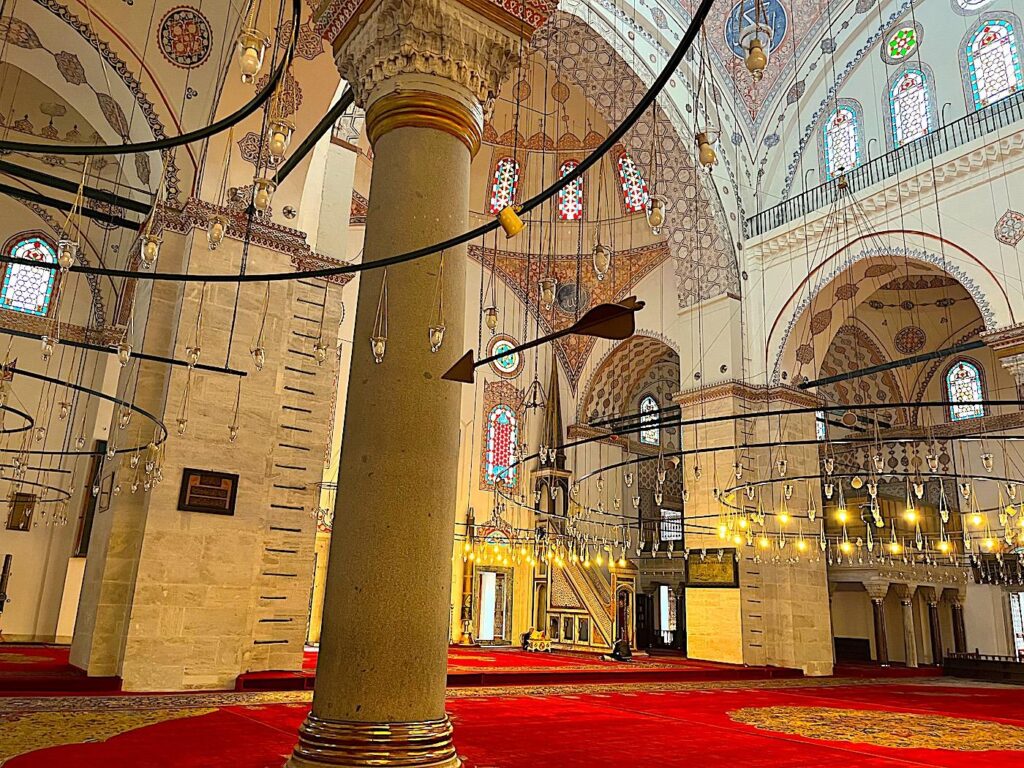
Architecturally, the Beyazıt Mosque marks a transitional point in Ottoman mosque design. While the Hagia Sophia influenced it, it predates the more structurally refined works of Mimar Sinan. The mosque features a central dome supported by semi-domes on either side, resting on massive piers. The use of arches and a rectangular courtyard with arcades is reminiscent of early Islamic architecture. The mosque has a balanced and harmonious layout, with two minarets flanking the courtyard and an elegant portico leading into the prayer hall. Inside, the mosque is more restrained than later examples, with its simplicity emphasising spatial clarity and devotional focus. Decorative elements, such as İznik tiles and marble columns, add to its quiet dignity.
The mosque complex also features the türbe (mausoleum) of Sultan Bayezid II, situated behind the mosque and surrounded by a tranquil garden. The türbe is notable for its understated design, in line with the sultan’s pious and scholarly character. Over the centuries, the mosque has undergone various restorations, particularly after earthquakes and fires, but it retains much of its original form.
Eyüp Sultan Mosque (1458)
Location: Eyüp Sultan Camii, Eyüp Merkez, 34050 Eyüpsultan/İstanbul. The official Eyüp Sultan District website link (Turkish). Opening Hours: Daily: As a working mosque, there are no set opening hours. Entrance Fee: Entry to the mosque is free.
The Eyüp Sultan Mosque, located in the Eyüp district of Istanbul, holds immense religious significance for Muslims, as it is believed to be the burial site of Eyüp Sultan (Abu Ayyub al-Ansari), a close companion of the Prophet Muhammad. The original mosque was commissioned by Mehmed the Conqueror shortly after the conquest of Constantinople in 1453, marking one of the earliest major Ottoman constructions in the city. However, the current structure is primarily the result of reconstructions and renovations, particularly a significant rebuilding ordered by Sultan Selim III between 1798 and 1800, with further restorations in later periods.
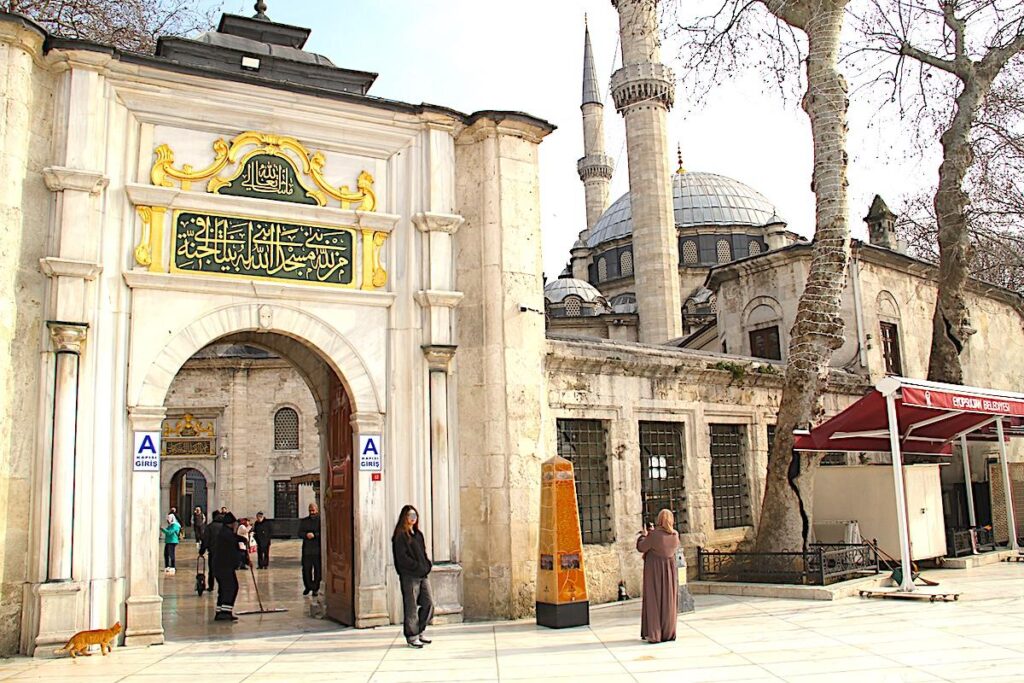

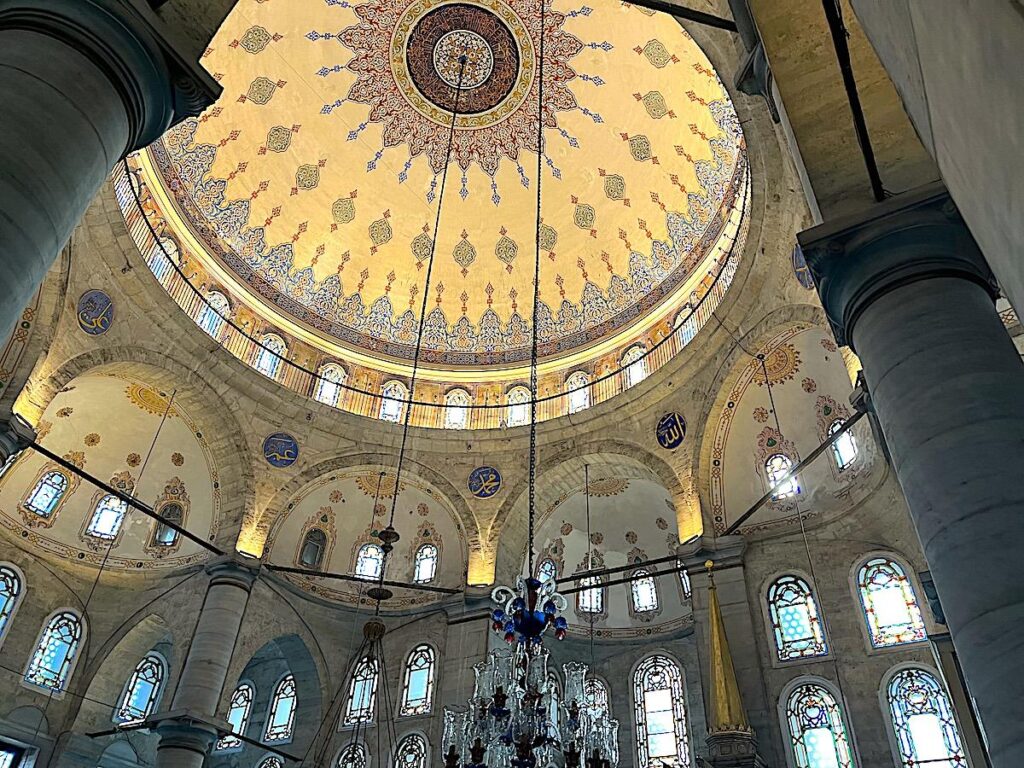
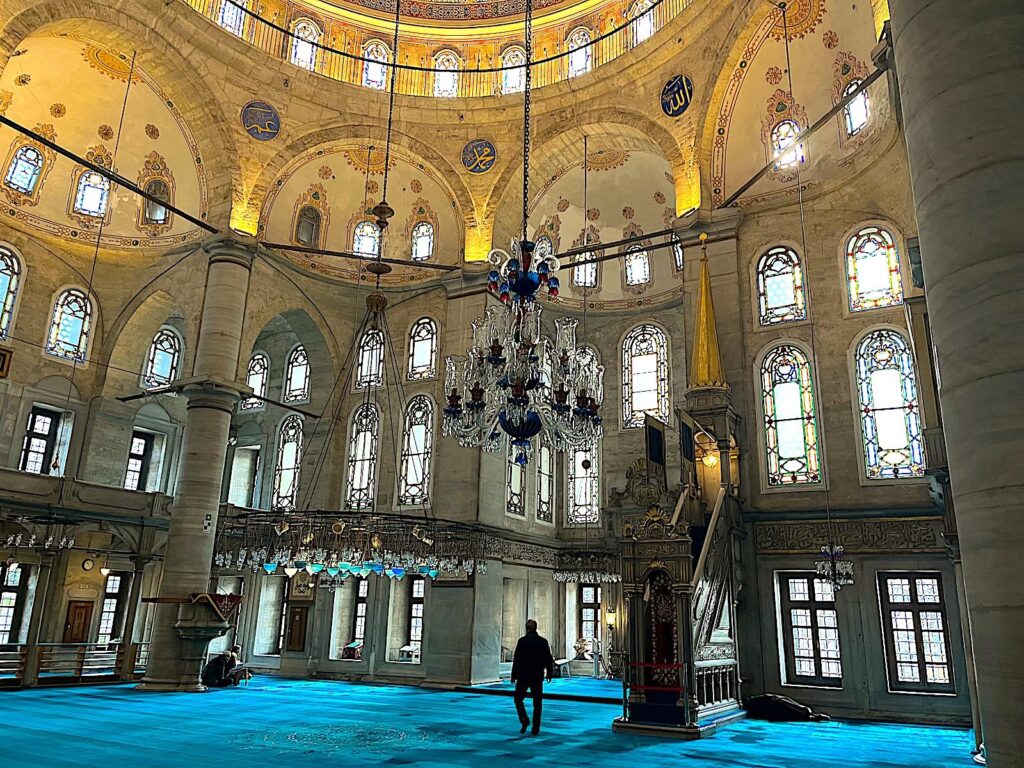

Architecturally, the Eyüp Sultan Mosque exhibits a blend of Ottoman and Baroque styles, reflecting the different periods of its construction. It features a central courtyard, a prayer hall with a single dome, and two minarets. The complex includes the tomb of Eyüp Sultan, which is a focal point of pilgrimage and prayer. The mosque’s interior is adorned with intricate tilework, calligraphy, and decorative elements, creating a serene and spiritual atmosphere. Its religious significance stems from its association with Eyüp Sultan, making it one of the most sacred sites in Istanbul for Muslims. The surrounding area, with its historical cemetery and religious atmosphere, further enhances its spiritual importance.
Mihrimah Sultan Mosque – Edirnekapı (1565)
Location: Mihrimah Sultan Camii, Karagümrük, Fevzi Paşa Cd. No:353, 34091 Fatih/İstanbul. No known official website. Opening Hours: Daily: As a working mosque, there are no set opening hours. Entrance Fee: Entry to the mosque is free.
The Mihrimah Sultan Mosque in Edirnekapı is one of two mosques in the city commissioned by Mihrimah Sultan, the daughter of Süleyman the Magnificent and Roxelana. This mosque, built between 1562 and 1565, was designed by the renowned Ottoman architect Mimar Sinan. It illustrates Sinan’s architectural genius and Mihrimah Sultan’s patronage. The mosque’s location on one of Istanbul’s highest hills is prominent within the city’s skyline.
Architecturally, the Mihrimah Sultan Mosque in Edirnekapı is notable for its spacious and luminous interior, achieved through the use of numerous windows. A defining feature is its large central dome, which appears to float, creating a sense of lightness and airiness. Sinan’s design emphasises the interplay of light and space, creating a serene and spiritual atmosphere. The mosque’s single minaret adds to its elegance and simplicity. The religious significance of the mosque lies not only in its function as a place of worship but also in its association with Mihrimah Sultan and Mimar Sinan, two prominent figures in Ottoman history.
Kılıç Ali Pasha Mosque (1580)
Location: Kılıç Ali Paşa Camii, Kemankeş Karamustafa Paşa, Kemeraltı Cd. No:50, 34425 Beyoğlu/İstanbul. No known official website. Opening Hours: Daily: As a working mosque, there are no set hours. Entrance Fee: Entry to the mosque is free.
The Kılıç Ali Pasha Mosque, located in the Tophane district of Istanbul, close to Galataport, was commissioned by the renowned Ottoman admiral Kılıç Ali Pasha. He was a highly respected figure in the Ottoman navy. The great Ottoman architect Mimar Sinan designed the mosque, which was constructed between 1578 and 1587, towards the end of Sinan’s illustrious career.

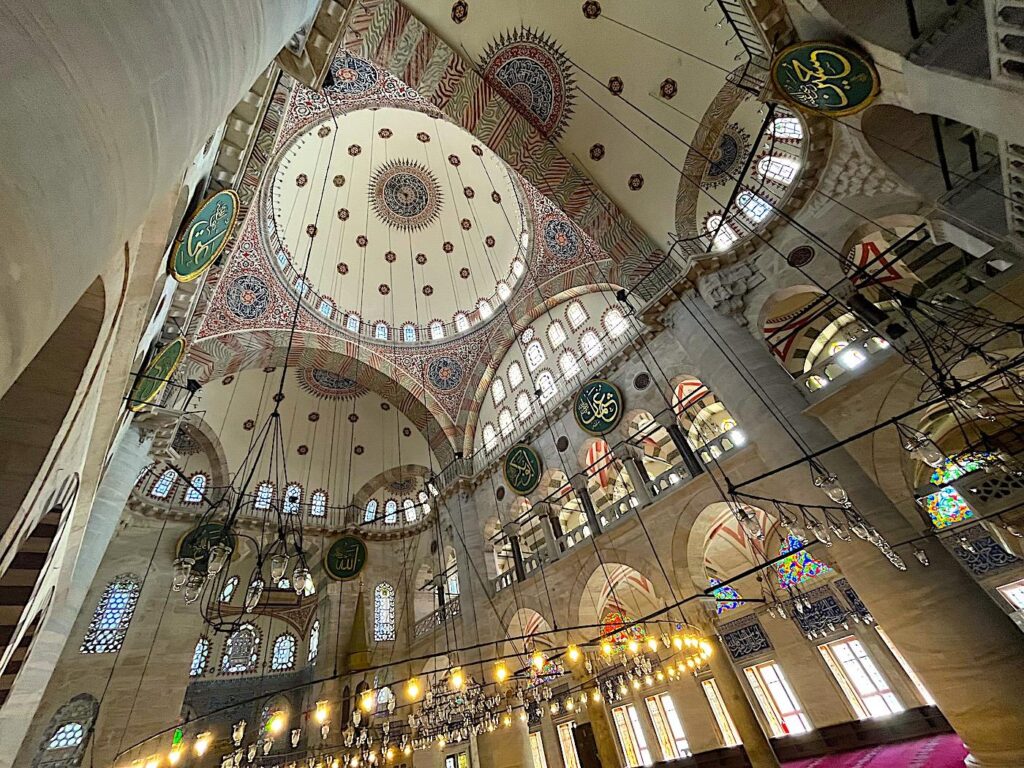
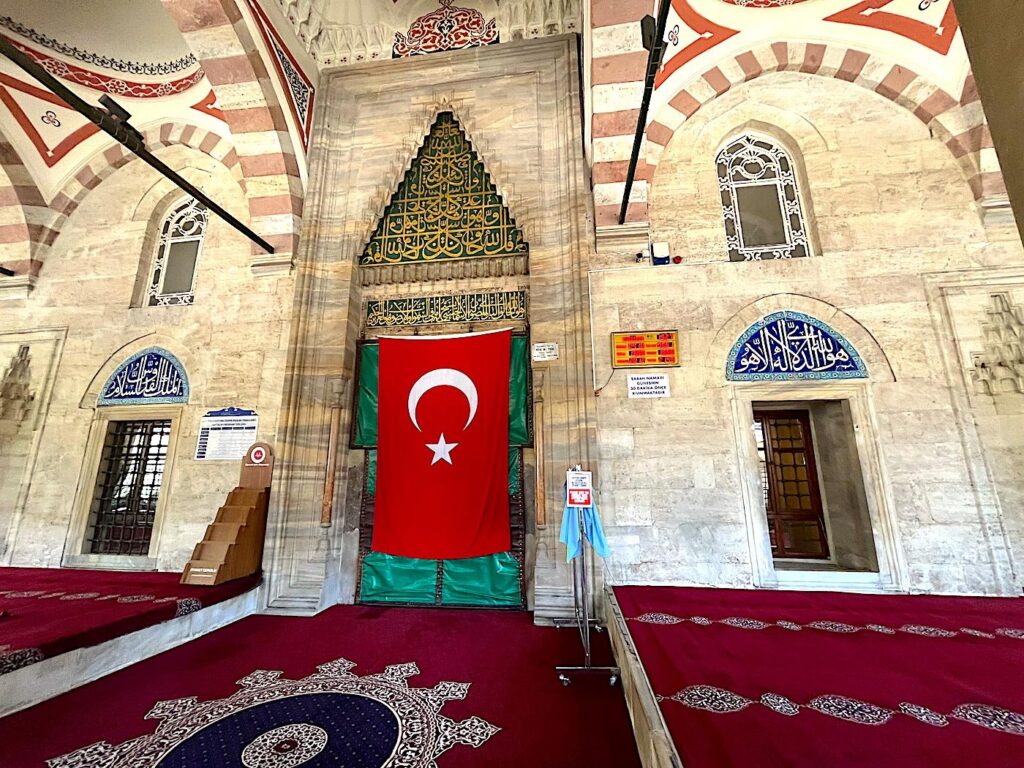
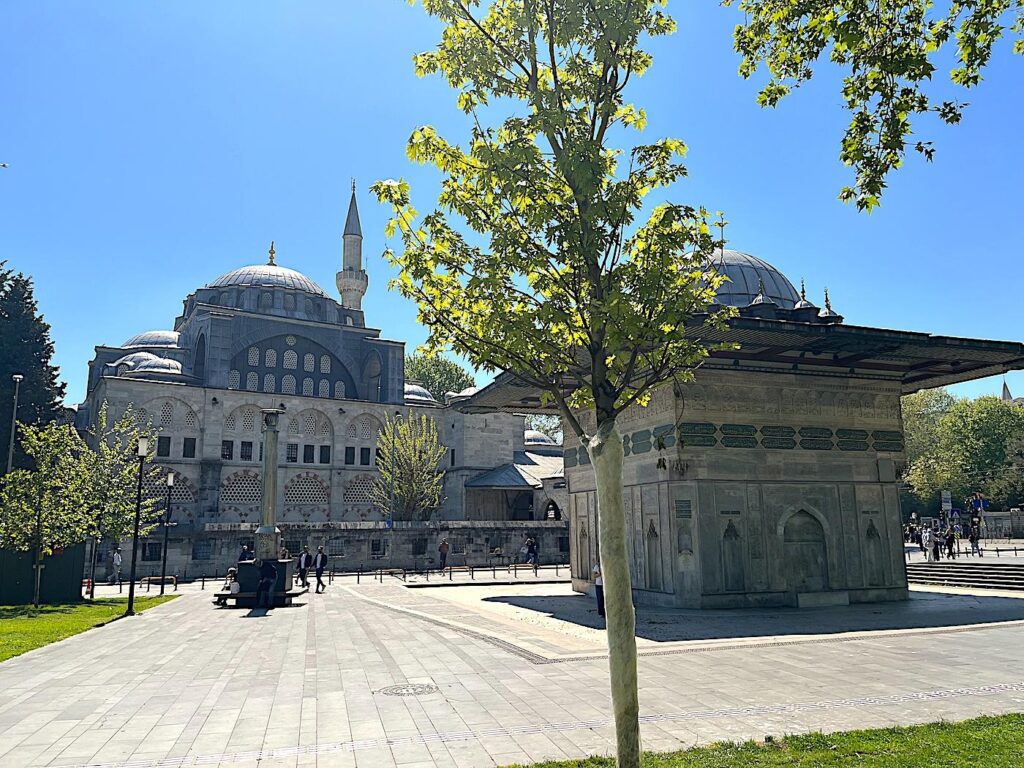
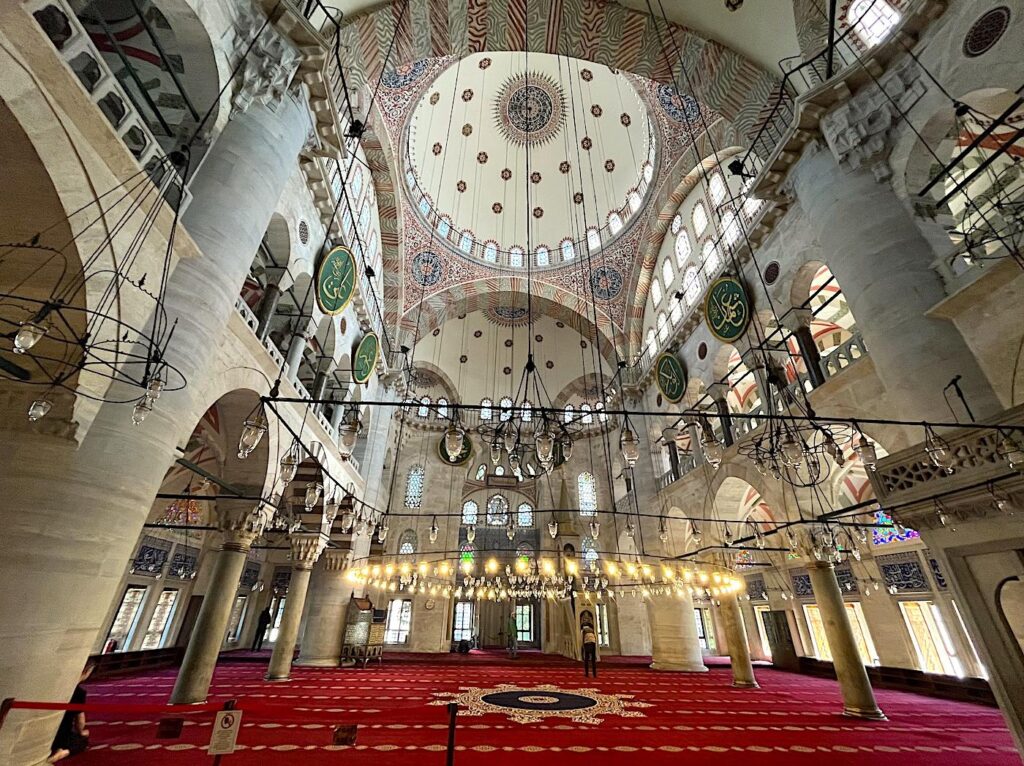
A unique architectural feature of the Kılıç Ali Pasha Mosque is its resemblance to a ship’s interior, reflecting Kılıç Ali Pasha’s maritime background. The elongated, rectangular prayer hall with a single dome is reminiscent of a ship’s hold. The interior is illuminated by numerous windows, creating a bright and airy atmosphere. The İznik tiles, although not as profuse as in some other mosques, are still of high quality and contribute significantly to the mosque’s aesthetic appeal. The religious significance lies in its function as a place of worship and its association with Kılıç Ali Pasha, a prominent figure in Ottoman naval history.
Other Significant Mosques of Istanbul
Sinan Paşa Mosque (1555)
Location: Sinan Paşa Camii, Sinanpaşa, Beşiktaş Cd. No:43, 34353 Beşiktaş/İstanbul. No known official website. Opening Hours: Daily: As a working mosque, there are no set opening hours. Entrance Fee: Entry to the mosque is free.
The Sinan Paşa Mosque in Beşiktaş is a 16th-century Ottoman mosque commissioned by Admiral Kaptan-ı Derya Sinan Paşa, a prominent naval commander under Sultan Suleiman the Magnificent. Completed around 1555, the mosque was designed by the imperial architect Mimar Sinan, making it one of the notable early works in his long career. The Admiral Sinan Paşa, who was also the brother of the influential Grand Vizier Rüstem Paşa, intended the mosque to serve the local community in Beşiktaş, a vital coastal district near the Ottoman naval base. The mosque originally stood near the sea, but later land reclamation and urban development pushed the coastline further outward.
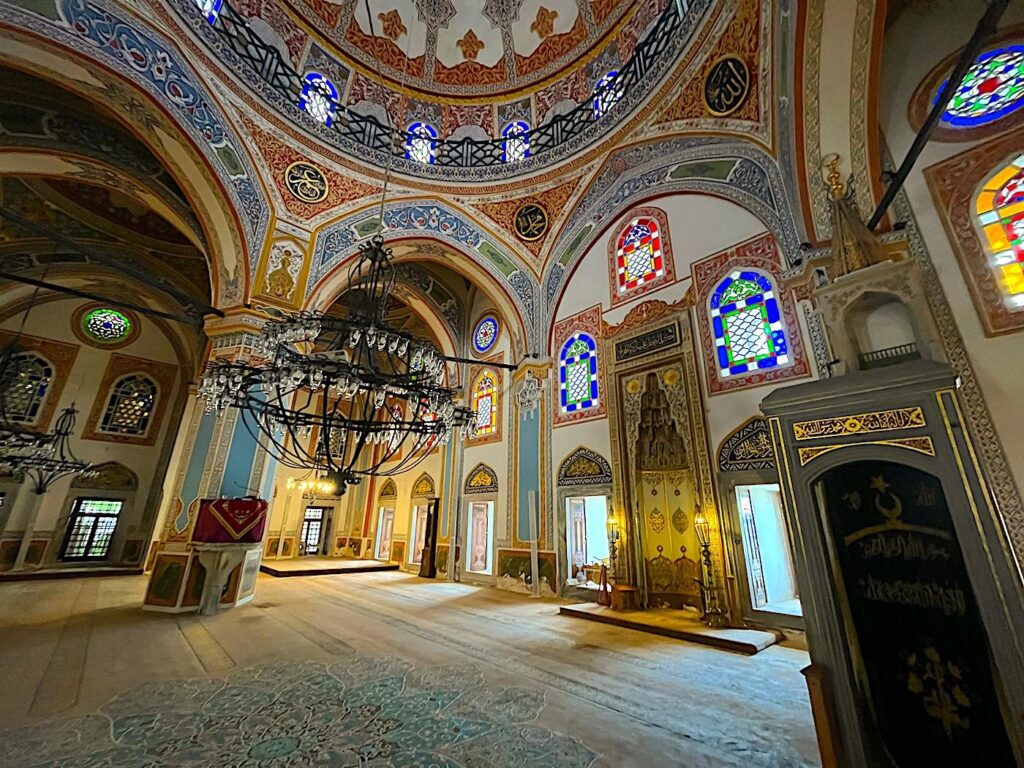
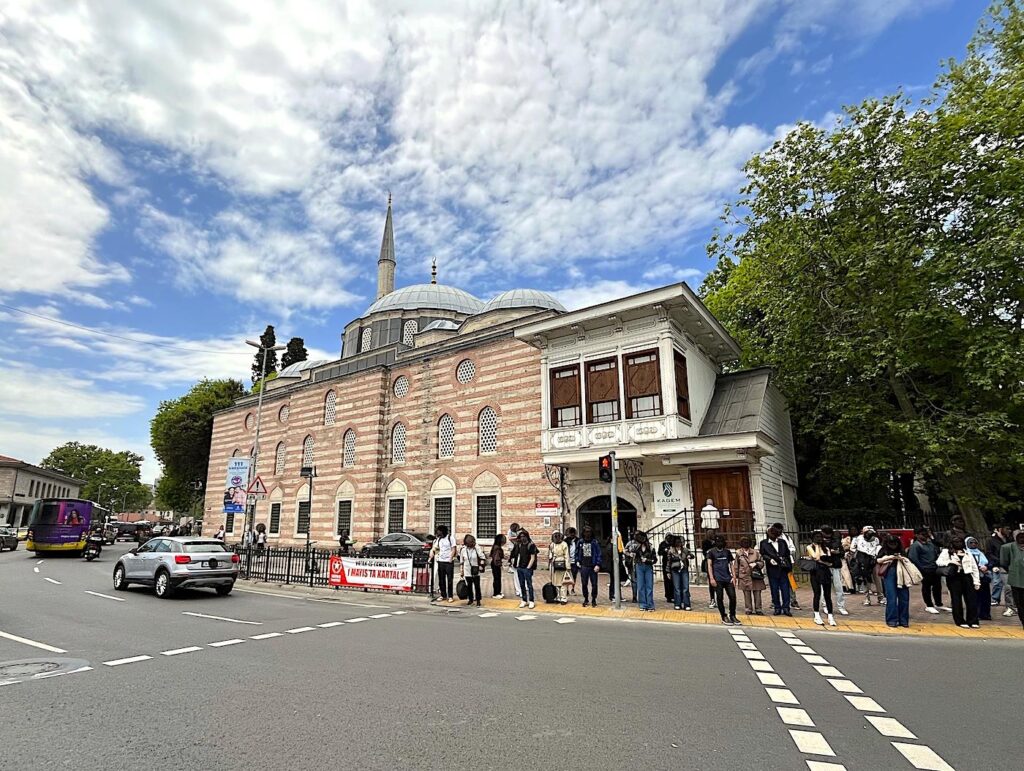
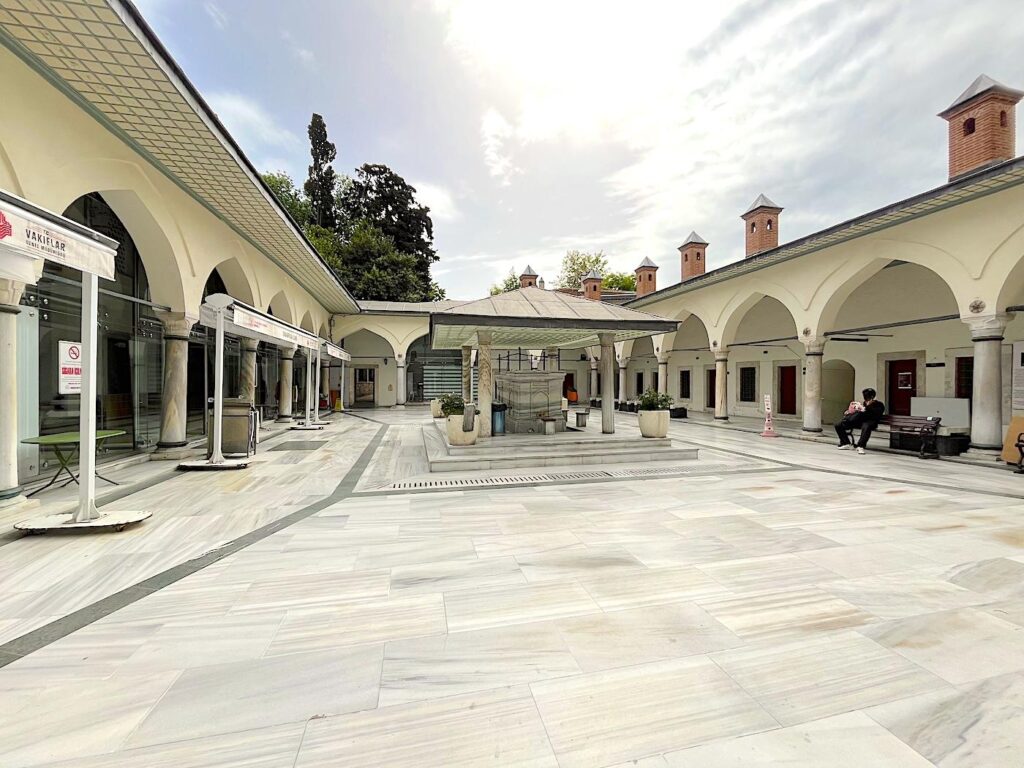
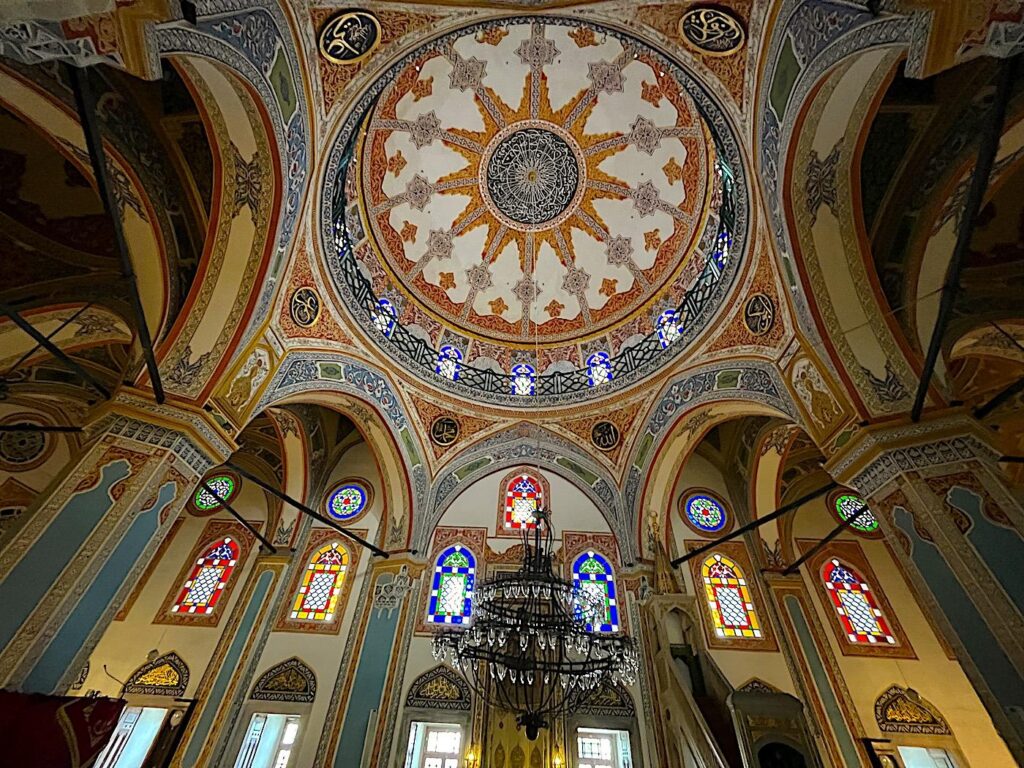

Architecturally, the Sinan Paşa Mosque exhibits many hallmarks of classical Ottoman design. It features a square prayer hall covered by a central dome resting on pendentives and supported by six arches, an approach that showcases Sinan’s early mastery of space and proportion. The mosque is primarily constructed of ashlar stone and features a spacious portico with five domes in front of the entrance. Its single minaret, graceful yet modest, contributes to the mosque’s balanced silhouette. The interior is simple and serene, emphasising geometry and light, with restrained decoration compared to the more elaborate works of Sinan’s later period. The mosque also originally included a madrasa and a small complex, parts of which have not survived in their original form.
The mosque is named after its patron, Admiral Sinan Paşa, not to be confused with Mimar Sinan, the architect. The Admiral’s tomb is situated in the garden adjacent to the mosque. His modest türbe (mausoleum) reflects the humility often associated with high-ranking Ottoman officials in death. Also in the garden is the tomb of Yahya Efendi, a revered Sufi mystic and contemporary of Sultan Suleiman, whose nearby tekke (dervish lodge) was a centre of spiritual activity.
The New Mosque – Yeni Cami (1665)
Location: Yeni Camii, Rüstem Paşa, Yeni Cami Cd. No:3, 34116 Fatih/İstanbul. The official Fatih District website link (Turkish). Opening Hours: Daily: As a working mosque, there are no set opening hours. Entrance Fee: Entry to the mosque is free.
Despite its name, the Yeni Cami, or New Mosque, is a historical Ottoman-era mosque located in the Eminönü district of Istanbul. Its construction was a lengthy process, beginning in 1597 under the patronage of Safiye Sultan, the mother of Sultan Mehmed III. However, due to various political and financial issues, the mosque was not completed until 1665, during the reign of Sultan Mehmed IV, with significant contributions from his mother, Turhan Hatice Sultan. The initial architect was Davut Ağa, a student of Mimar Sinan, and later, the project was finished by Mustafa Ağa.
Architecturally, the New Mosque exhibits a classic Ottoman imperial style, featuring a large central dome surrounded by smaller semi-domes. The interior is richly decorated with intricate İznik tiles, gold leaf, and carved marble. The mosque complex, or külliye, originally included various supporting structures, such as a hospital, a school, and the renowned Spice Bazaar, which remains a prominent landmark today. The religious significance of the mosque is tied to its role as a significant place of worship in Istanbul and its historical importance as one of the last great imperial mosques of the Ottoman era.
Laleli Mosque (1763)
Location: Laleli Camii, Kemal Paşa, Ordu Cd., 34134 Fatih/İstanbul. No known official website. Opening Hours: Daily: As a working mosque, there are no set opening hours. Entrance Fee: Entry to the mosque is free.
The Laleli Mosque, also known as the “Tulip Mosque,” is an 18th-century Ottoman imperial mosque in Istanbul’s Laleli district. It was commissioned by Sultan Mustafa III and constructed between 1760 and 1763. The mosque’s design is attributed to architect Mehmet Tahir Agha. Notably, the mosque’s name derives from a holy person, Laleli Baba, who the Sultan highly regarded. The mosque is part of a larger complex that initially included various structures like a madrasa, a caravansary, and shops.
Architecturally, the Laleli Mosque is a significant example of Ottoman Baroque architecture, a style that gained popularity during the 18th century. It features a central dome supported by semi-domes, and its interior is characterized by ornate decorations, including marble and detailed stonework. A distinctive feature is the raised platform upon which the mosque is built, with shops located beneath it, which provide financial support for the mosque. Blending baroque style with traditional Ottoman elements gives the mosque a unique and elegant appearance. The complex surrounding the mosque also held religious and social significance.
Nuruosmaniye Mosque (1755)
Location: Nuruosmaniye Camii, Molla Fenari, Vezirhan Cd. No:4, 34120 Fatih/İstanbul. No known official website. Opening Hours: Daily: As a working mosque, there are no set opening hours. Entrance Fee: Entry to the mosque is free.
The Nuruosmaniye Mosque in Istanbul’s Çemberlitaş neighbourhood is a significant example of 18th-century Ottoman architecture, particularly the Ottoman Baroque style. Its construction began under Sultan Mahmud I in 1748 and was completed in 1755 during the reign of Sultan Osman III. Notably, the mosque’s design was overseen by architect Simon Kalfa, marking a shift in Ottoman architectural trends by incorporating Baroque influences.
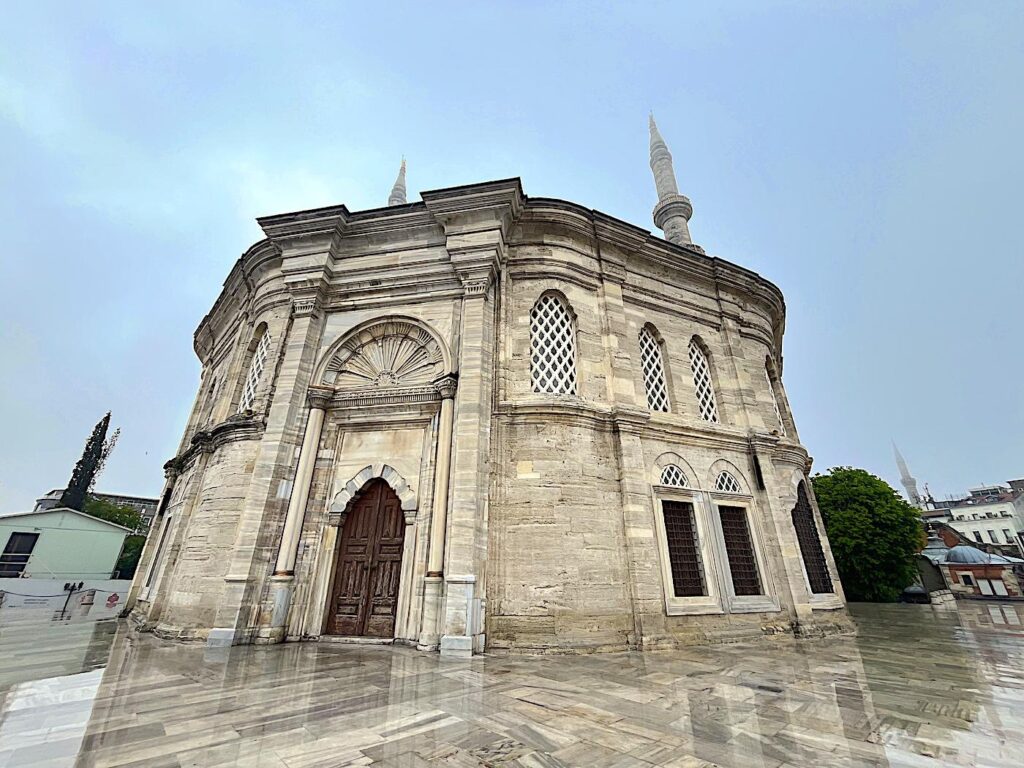

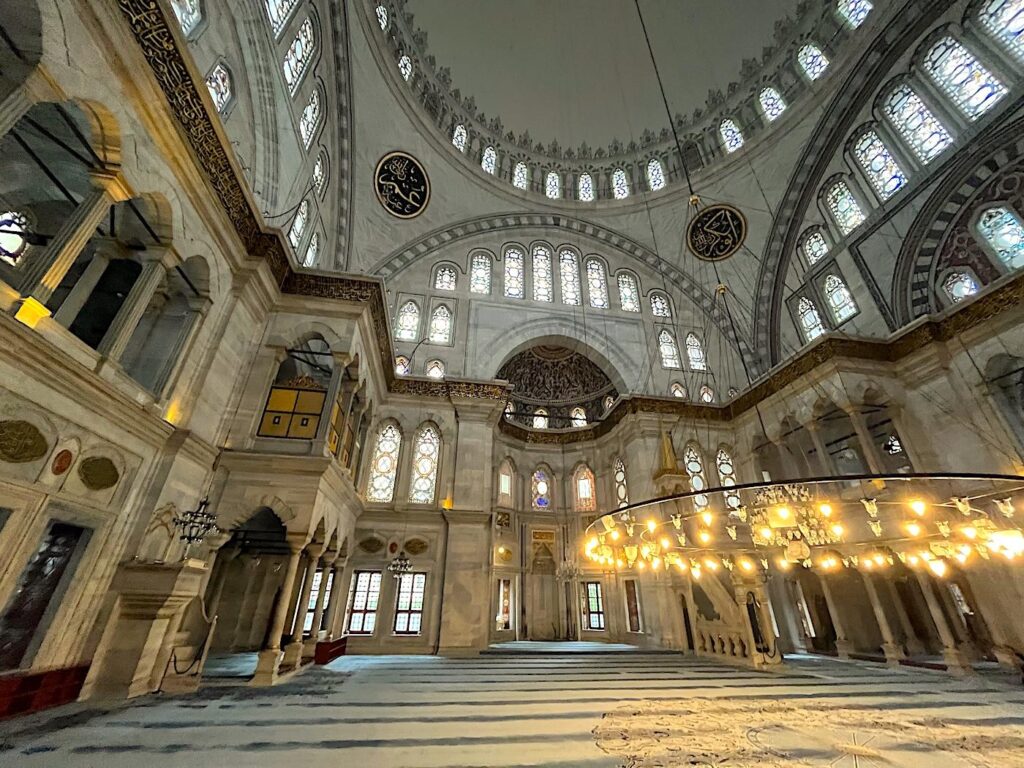
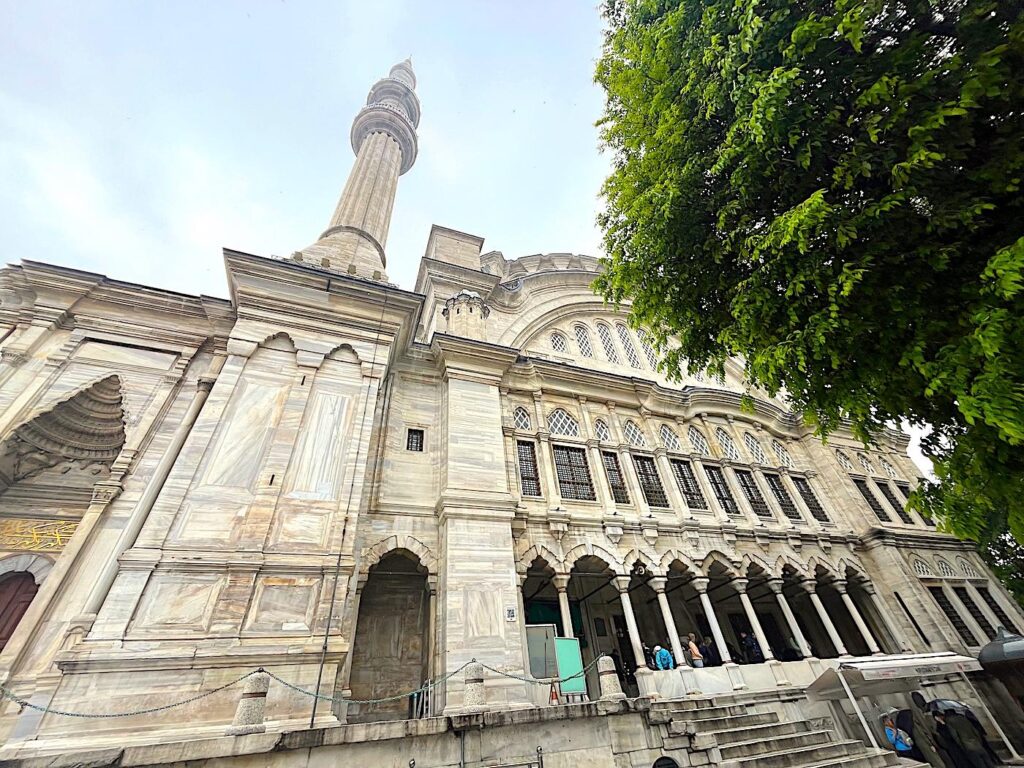
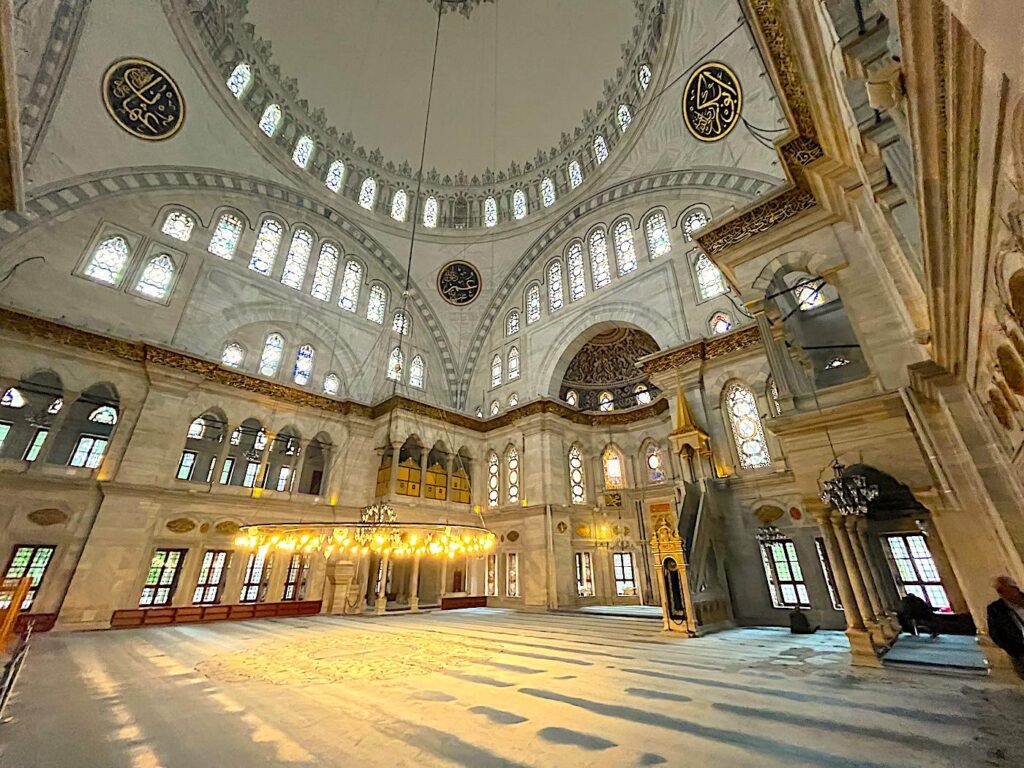
Architecturally, the Nuruosmaniye Mosque is distinguished by its unique features. It was the first prominent Ottoman mosque to adopt Baroque elements, which can be seen in its curved courtyard, ornate decorations, and the use of natural light. The mosque’s large central dome, illuminated by numerous windows, creates a bright and spacious interior. The complex also includes a library, madrasa, and other supporting structures, reflecting its role as a religious and social centre. The blending of traditional Ottoman design with European Baroque influences gives the mosque a distinct and elegant character.
Dolmabahçe Mosque (1855)
Location: Dolmabahçe Camii, Ömer Avni, Meclis-i Mebusan Cd. No:34, 34427 Beyoğlu/İstanbul. There is no known official website; however, the Islam Encyclopedia Website. Opening Hours: Daily: As a working mosque, there are no set opening hours. Entrance Fee: Entry to the mosque is free.
The Dolmabahçe Mosque, also known as the Bezm-i Alem Valide Sultan Mosque, is a grand imperial mosque situated along the Bosphorus shoreline in the Dolmabahçe district of Istanbul. Commissioned by Bezm-i Alem Valide Sultan, the mother of Sultan Abdülmecid I, construction began in 1853 but was completed in 1855 after her death, under the patronage of her son. The mosque was intended to complement the nearby Dolmabahçe Palace, the new administrative and residential centre of the Ottoman Empire, reflecting the shifting power and aesthetic ideals of the 19th-century Ottoman court during the Tanzimat era, a period of sweeping modernisation and Westernisation.
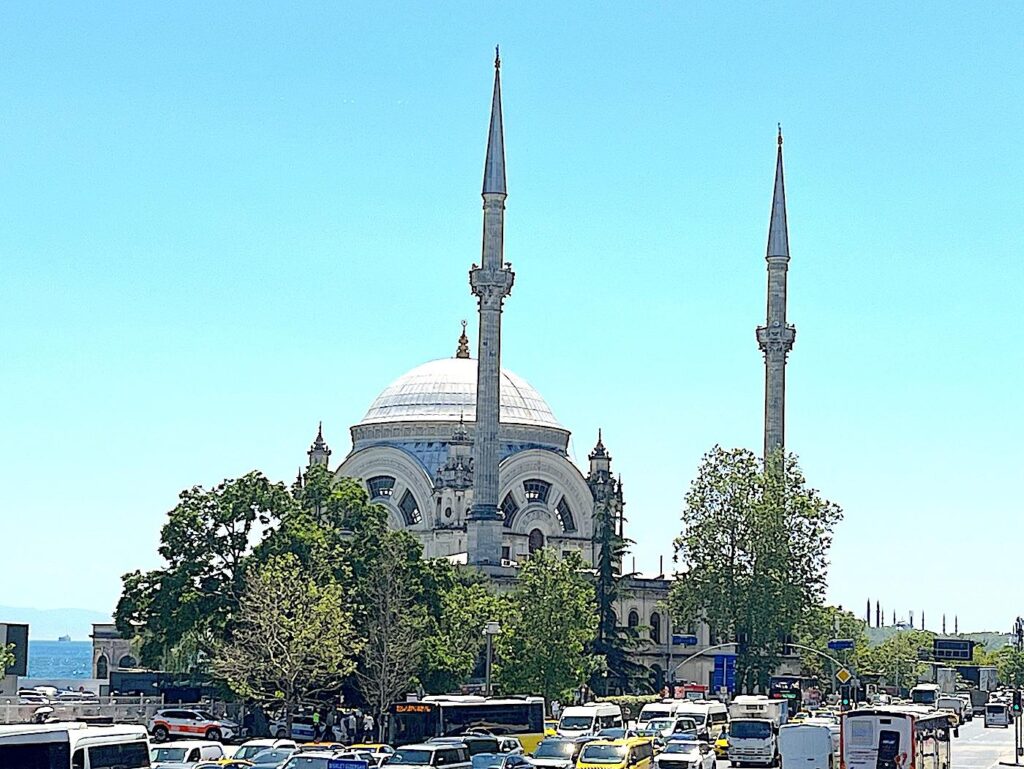
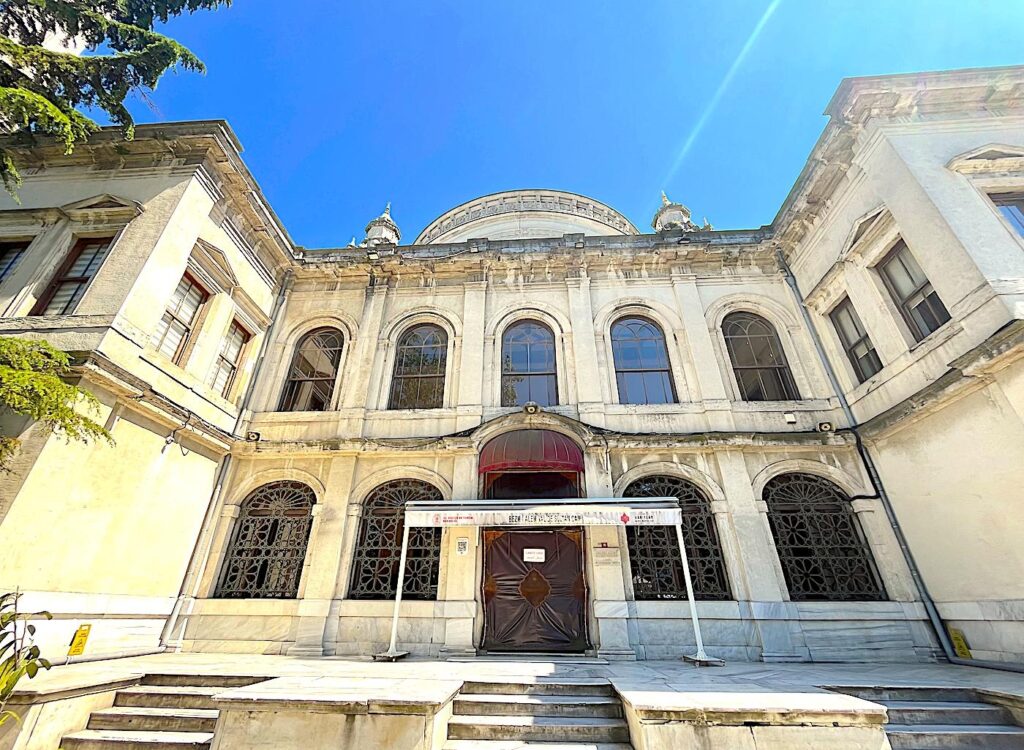
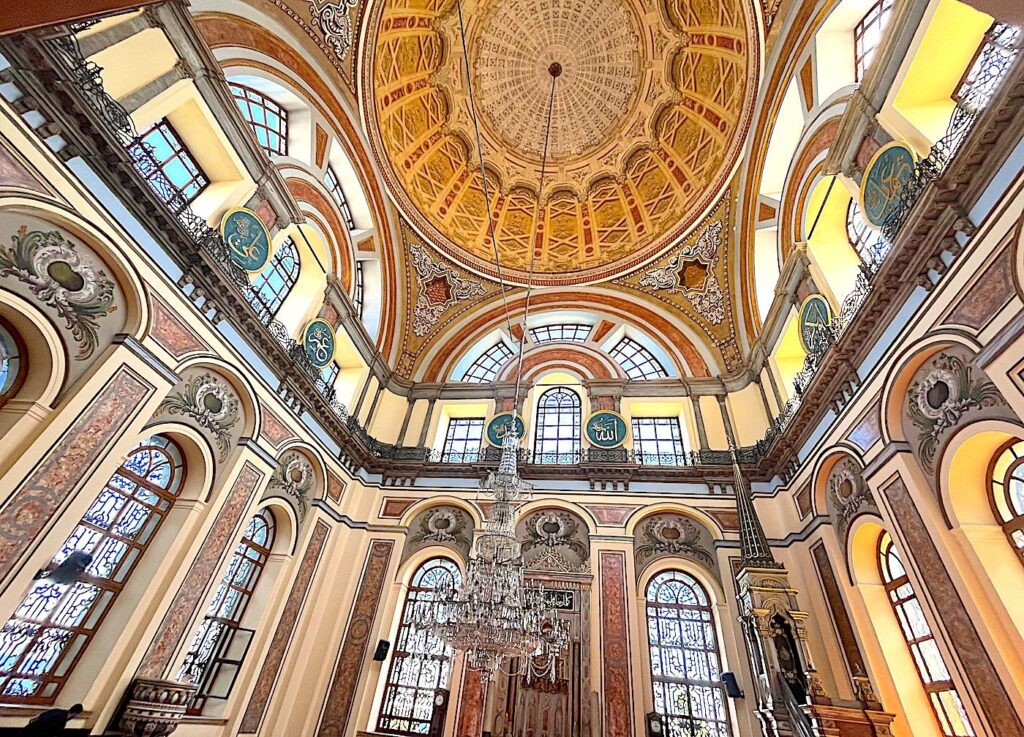
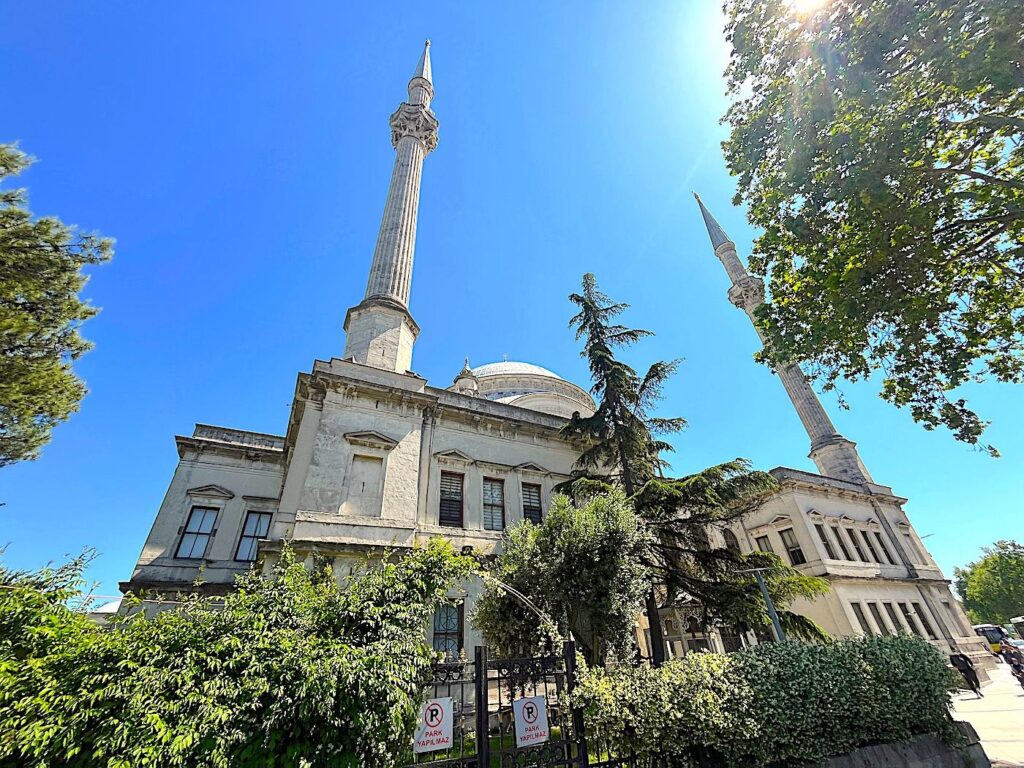
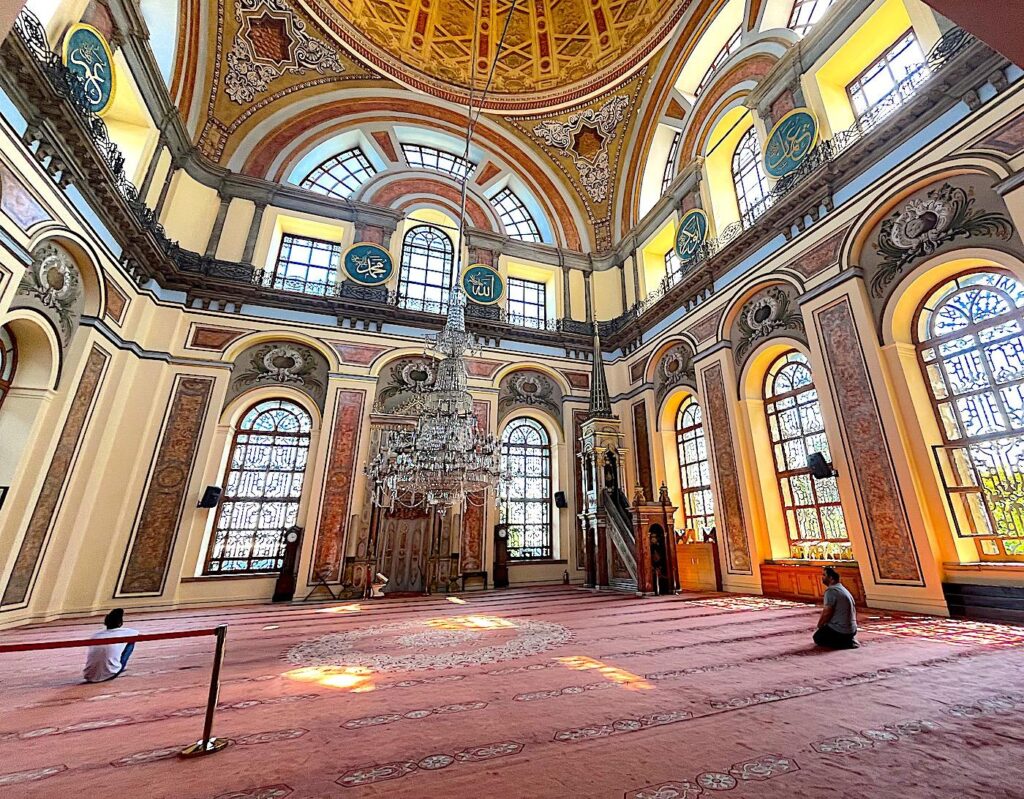
Architecturally, the Dolmabahçe Mosque is a striking example of Ottoman Baroque and Empire styles, heavily influenced by European neoclassical architecture. Designed by the Armenian-Ottoman architect Garabet Balyan and his son Nigoğayos Balyan, it departs from traditional Ottoman mosque forms with its grand façade, ornate detailing, and large arched windows that flood the interior with natural light. The mosque features a high central dome resting on pendentives and flanked by two elegant minarets. Its interior is richly decorated with gilded stucco, crystal chandeliers, and delicate floral motifs, mirroring the grandeur and opulence of the nearby Dolmabahçe Palace. The prayer hall is spacious and symmetrical, emphasising verticality and European palace aesthetics more than classical Islamic architectural principles.
It served not only as a royal mosque but also as a visible statement of the Ottoman Empire’s embrace of European artistic and ideological currents. Its location at the entrance to the Bosphorus and proximity to the palace made it the spiritual centre for the court, while its lavish design aligned with the empire’s efforts to project modernity and power.
Ortaköy Mosque (1855)
Location: Büyük Mecidiye Camii, Mecidiye, 34347 Beşiktaş/İstanbul. No known official website. Opening Hours: Daily: As a working mosque, there are no set opening hours. Entrance Fee: Entry to the mosque is free.
The Ortaköy Mosque, officially known as the Büyük Mecidiye Camii, is a stunning example of Neo-Baroque architecture situated along the Bosphorus in the Ortaköy neighborhood of Istanbul. It was commissioned by Sultan Abdülmecid I and constructed between 1853 and 1855. The mosque was designed by the Armenian architect Nigoğayos Balyan, a member of the renowned Balyan family of court architects. Its picturesque location and elegant design have made it one of Istanbul’s most iconic landmarks.
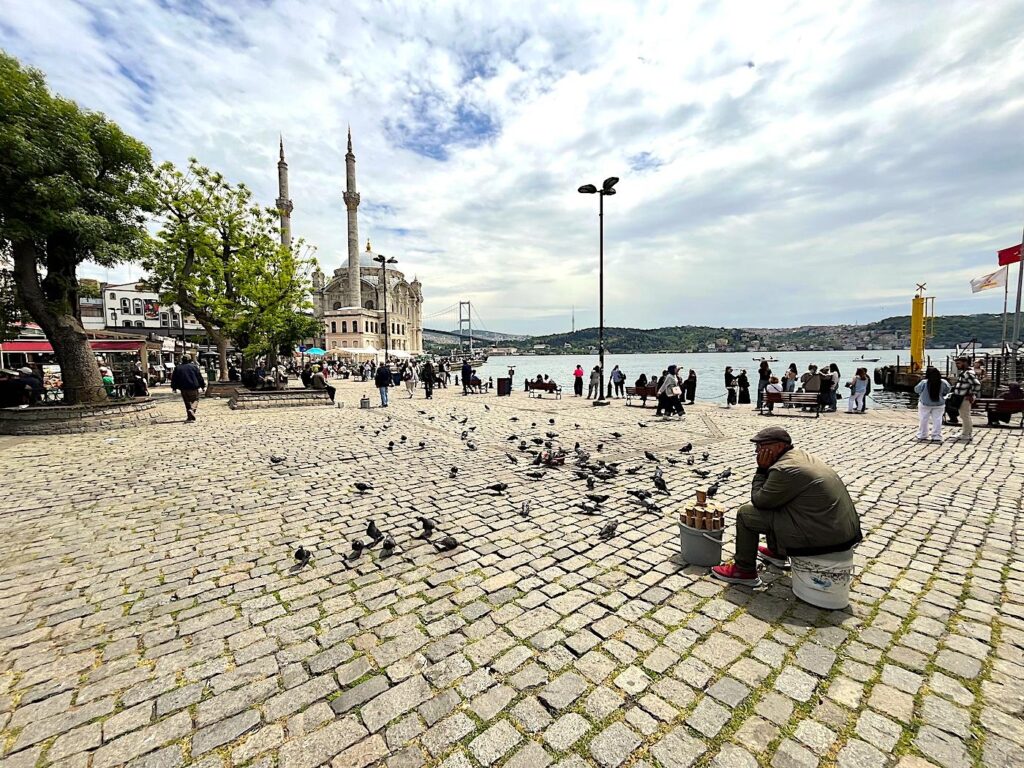


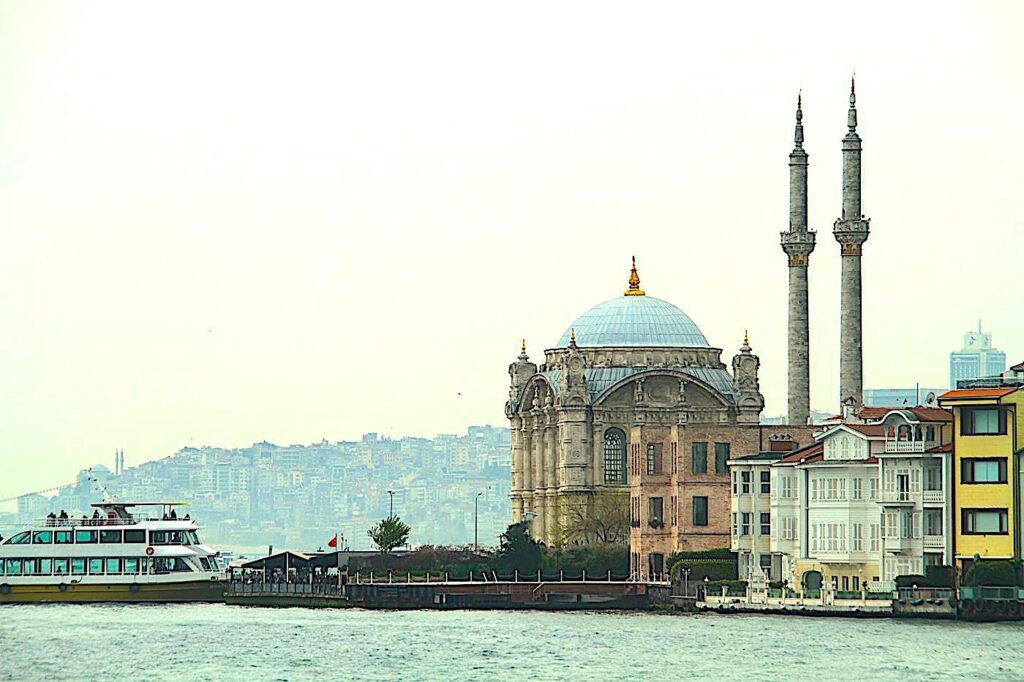
Architecturally, the Ortaköy Mosque is characterised by its ornate Neo-Baroque style, which was popular during the Tanzimat period of the Ottoman Empire. Its most prominent features include its two slender minarets and high, arched windows that allow ample natural light into the prayer hall, illuminating the intricate interior decorations. The mosque’s interior is adorned with elaborate stucco work, calligraphic inscriptions, and marble details. Its location directly on the Bosphorus provides breathtaking views, enhancing its spiritual and aesthetic appeal.
Cihangir Mosque (1560, reconstructed 1890)
Location: Cihangir Camii, Pürtelaş Hasan Efendi, Münir Özkul Sok. No:22, 34427 Beyoğlu/İstanbul. No known official website. Opening Hours: Daily: As a working mosque, there are no set hours. Entrance Fee: Entry to the mosque is free.
The Cihangir Mosque, perched on a hill overlooking the Bosphorus, holds a poignant history. It was initially commissioned by Süleyman the Magnificent in memory of his son, Şehzade Cihangir, who died at a young age. The original structure, designed by the renowned architect Mimar Sinan, was completed around 1559-1560. However, the mosque has undergone numerous historical reconstructions due to recurring fires and earthquakes. The current structure largely dates back to a reconstruction in 1890, during the reign of Sultan Abdul Hamid II. Therefore, while Mimar Sinan designed the original mosque, the present-day structure reflects later architectural influences.
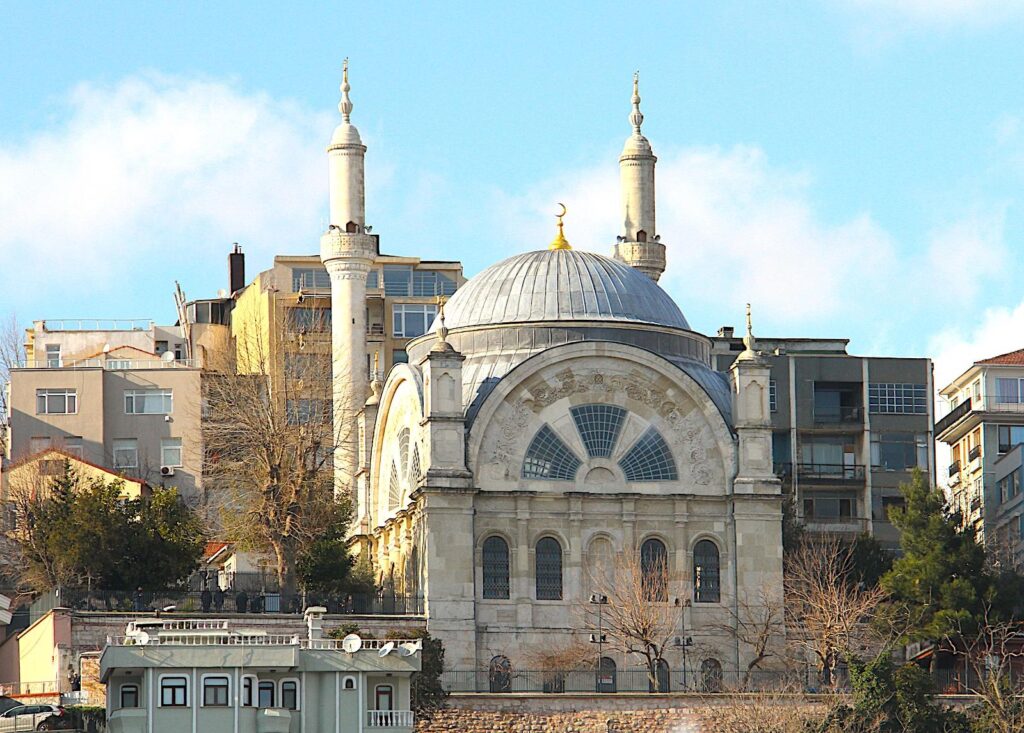
A significant feature of the Cihangir Mosque is its commanding location, which provides breathtaking panoramic views of the Bosphorus and the city. Architecturally, the mosque reflects Ottoman styles, although due to the rebuilds, it has elements from later periods. Notably, the mosque has a square plan and a single dome.
Molla Çelebi (Fındıklı) Mosque (1584)
Location: Molla Çelebi Camii, Ömer Avni, Meclis-i Mebusan Cd. No:26, 34427 Beyoğlu/İstanbul, Türkiye. No known official website. Opening Hours: Closed due to fire damage (as of May 2025).
The Molla Çelebi Mosque, also known as the Fındıklı Mosque, is a historic Ottoman mosque located along the Bosphorus in the Fındıklı neighbourhood of Istanbul. Commissioned by Kazasker Mehmet Vusuli Efendi, also known as Molla Çelebi, the mosque was designed by the renowned imperial architect Mimar Sinan and completed in 1584 during the reign of Sultan Murad III. It was one of Sinan’s last projects. Positioned strategically on the shoreline, the mosque served as a place of worship and a visual landmark for those arriving in the city by sea.

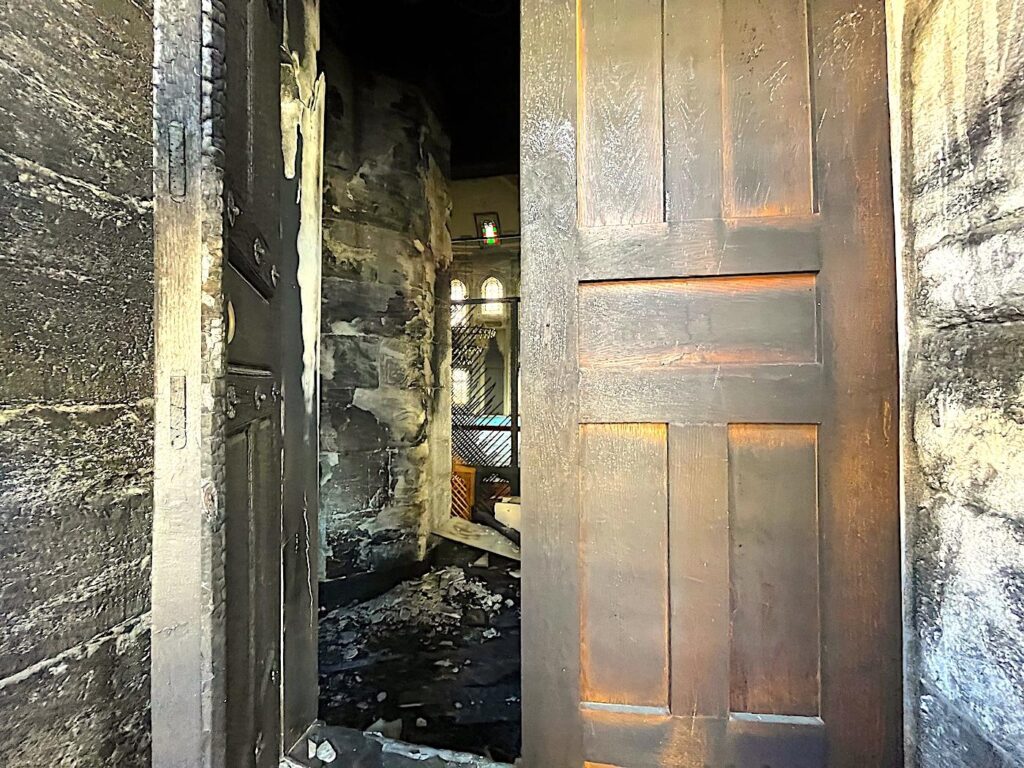
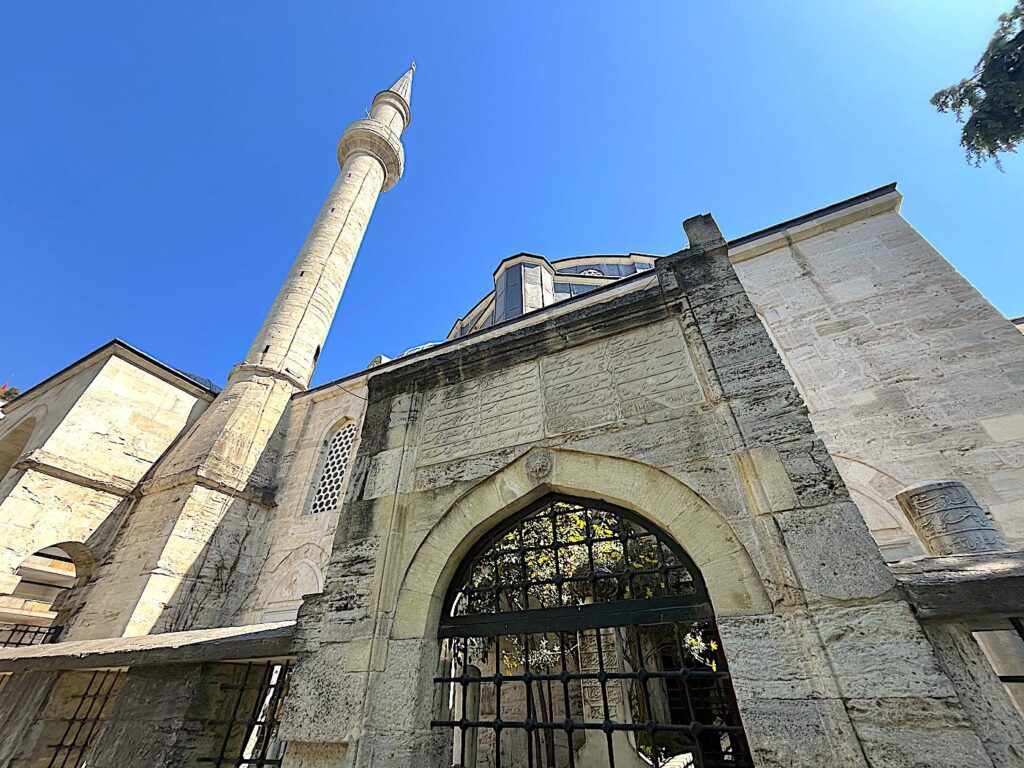
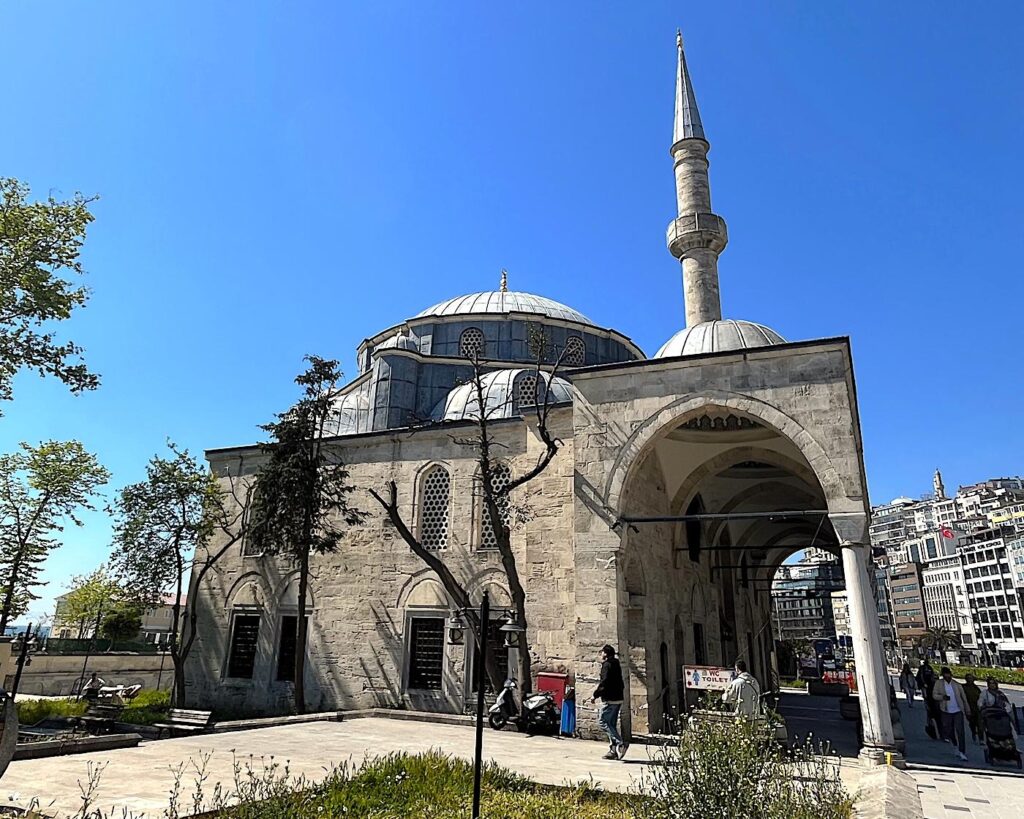
The Molla Çelebi Mosque Architecturally reflects the harmonious proportions and refined elegance typical of Sinan’s mature style. The mosque features a central dome supported by four arches flanked by semi-domes on two sides, creating a balanced and symmetrical interior space. The single minaret and modest courtyard contribute to its compact yet dignified appearance. The mosque is notable for its finely carved stonework, intricate calligraphy, and subtle decorative details that blend simplicity with sophistication. Its placement on a raised platform overlooking the Bosphorus adds to its visual impact, integrating architecture with the natural beauty of its surroundings.
In the early hours of 24 March 2025, a fire broke out in the Molla Çelebi Mosque due to an electrical fault, causing material damage to the mosque’s interior.
Nusretiye Mosque (1826)
Location: Nusretiye Camii, Kılıçali Paşa, Meclis-i Mebusan Cd. No:4, 34425 Beyoğlu/İstanbul, Türkiye. No known official website. Opening Hours: Daily: As a working mosque, there are no set hours. Entrance Fee: Entry to the mosque is free.
The Nusretiye Mosque, located in the Tophane district of Istanbul adjacent to Galataport, was commissioned by Sultan Mahmud II and completed in 1826. It was built on the site of an earlier mosque that had been destroyed by fire. It was intended to symbolise the sultan’s modernisation efforts, especially following the abolition of the Janissary corps in the same year, a reform known as the Auspicious Incident (Vaka-i Hayriye). The name “Nusretiye,” meaning “Victory” or “Divine Help,” reflects this decisive shift in Ottoman military and political structure. Designed by Armenian-Ottoman architect Krikor Balyan, the mosque served as a religious and political statement during a significant transformation in the empire.
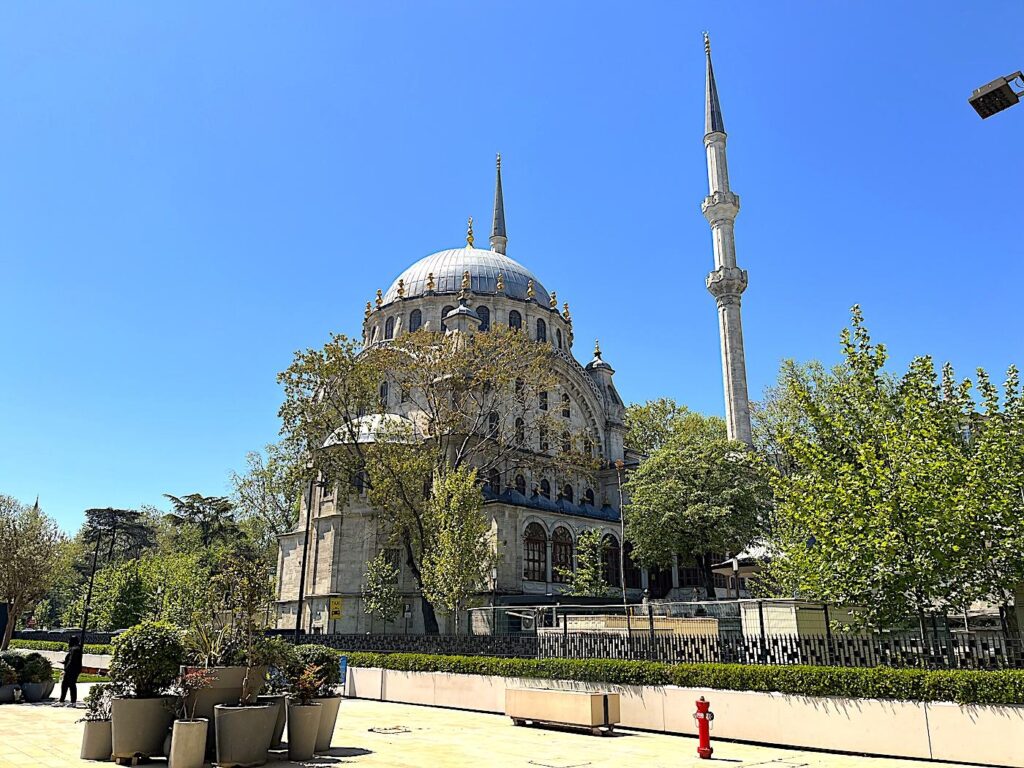
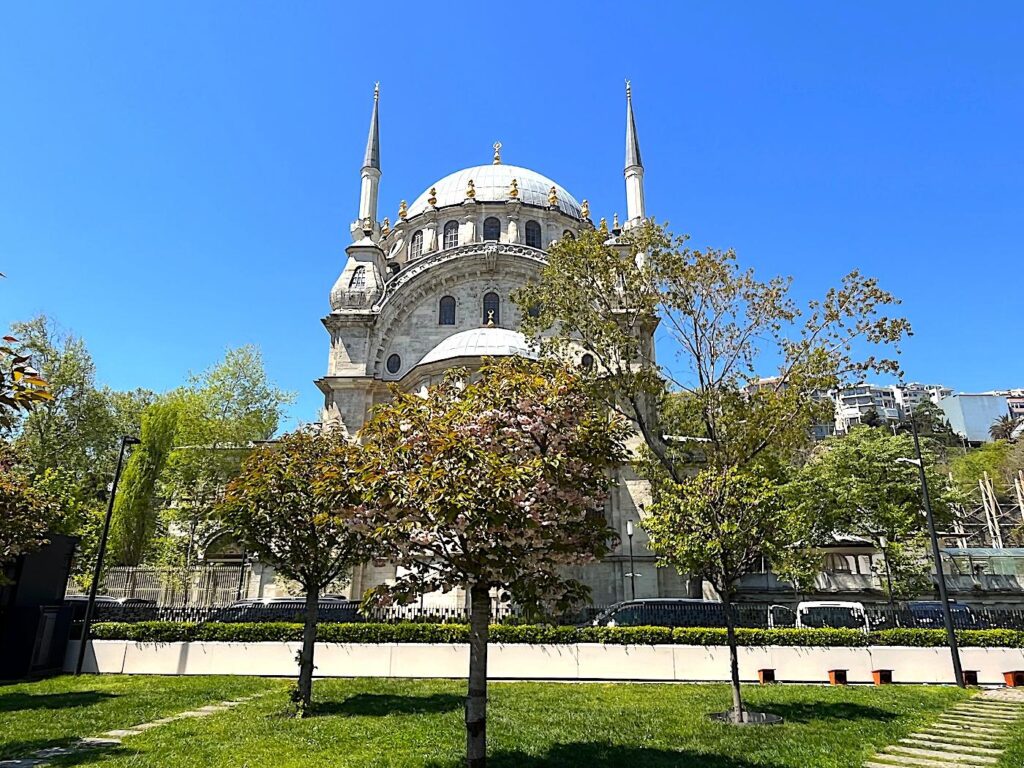
Architecturally, the Nusretiye Mosque is a striking example of Ottoman Baroque style, heavily influenced by European neoclassical and Rococo trends of the 18th and 19th centuries. It features a central dome supported by semi-domes, twin minarets with multiple balconies, and a highly ornate exterior adorned with curved lines, arabesques, and elaborate stonework. The interior is richly decorated with calligraphy, gilded detailing, and marble columns, all of which contribute to a sense of grandeur and dynamism. Unlike the classical simplicity of earlier mosques by Mimar Sinan, Nusretiye showcases a more decorative and theatrical style, marking a distinct evolution in Ottoman religious architecture aligned with the broader Tanzimat-era reforms.
Teşvikiye Mosque (1794/1854)
Location: Teşvikiye Camii, Teşvikiye Mah, Teşvikiye, 34365 Şişli/İstanbul. No known official website. Opening Hours: Daily: As a working mosque, there are no set hours. Entrance Fee: Entry to the mosque is free.
The Teşvikiye Mosque, situated in the upscale Nişantaşı neighbourhood of Istanbul, is a notable example of late Ottoman architecture that blends traditional Islamic design with European influences. Initially commissioned by Sultan Selim III in 1794 as part of his modernisation efforts, the mosque was later rebuilt in its current form by Sultan Abdülmecid I in 1854. It was part of a broader imperial initiative to encourage settlement in the newly developing Teşvikiye district, hence the name “Teşvikiye,” meaning “encouragement.” The mosque helped establish the area as a fashionable quarter for the elite of Ottoman society and later for the emerging bourgeoisie of the Republic era.

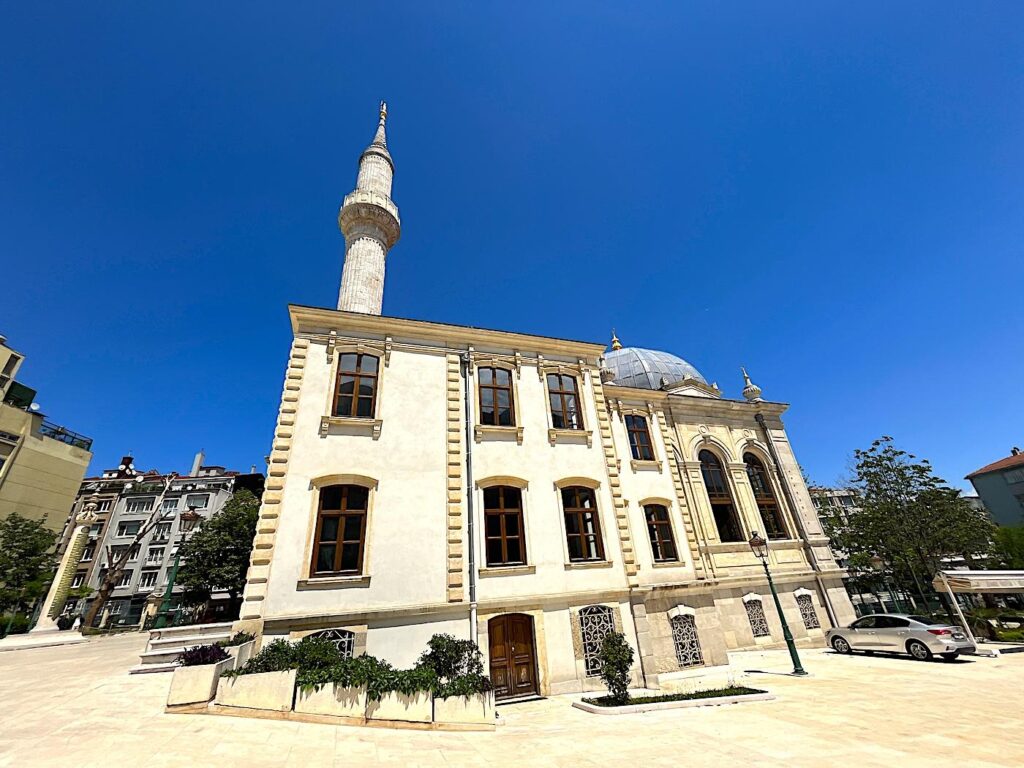
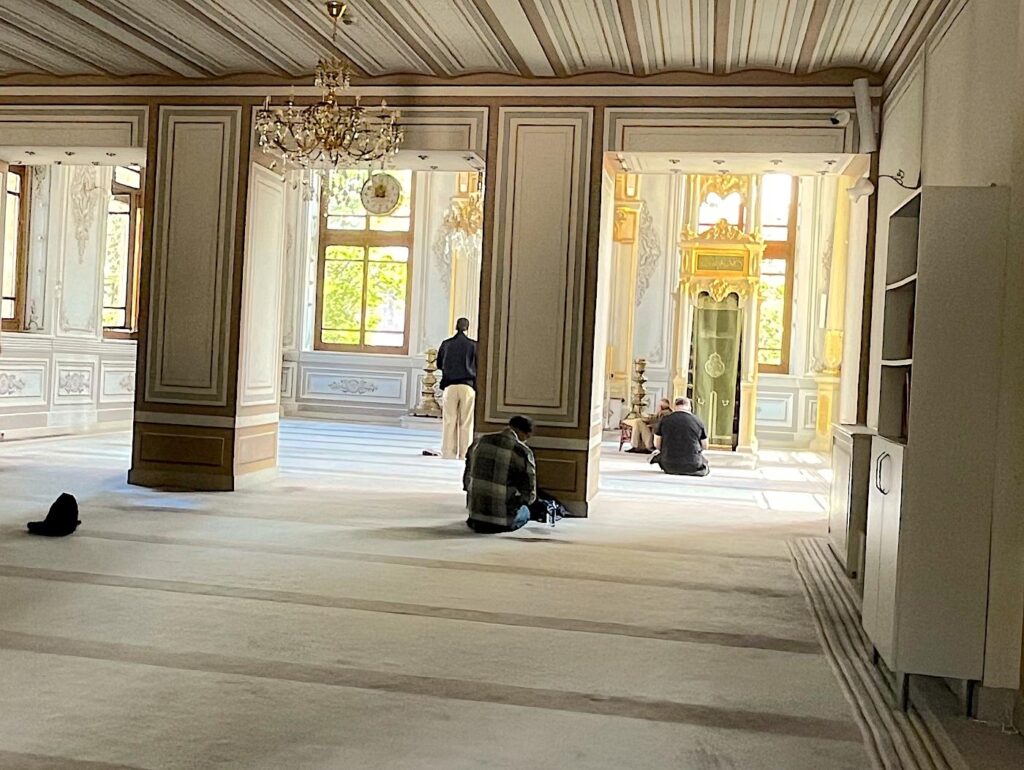
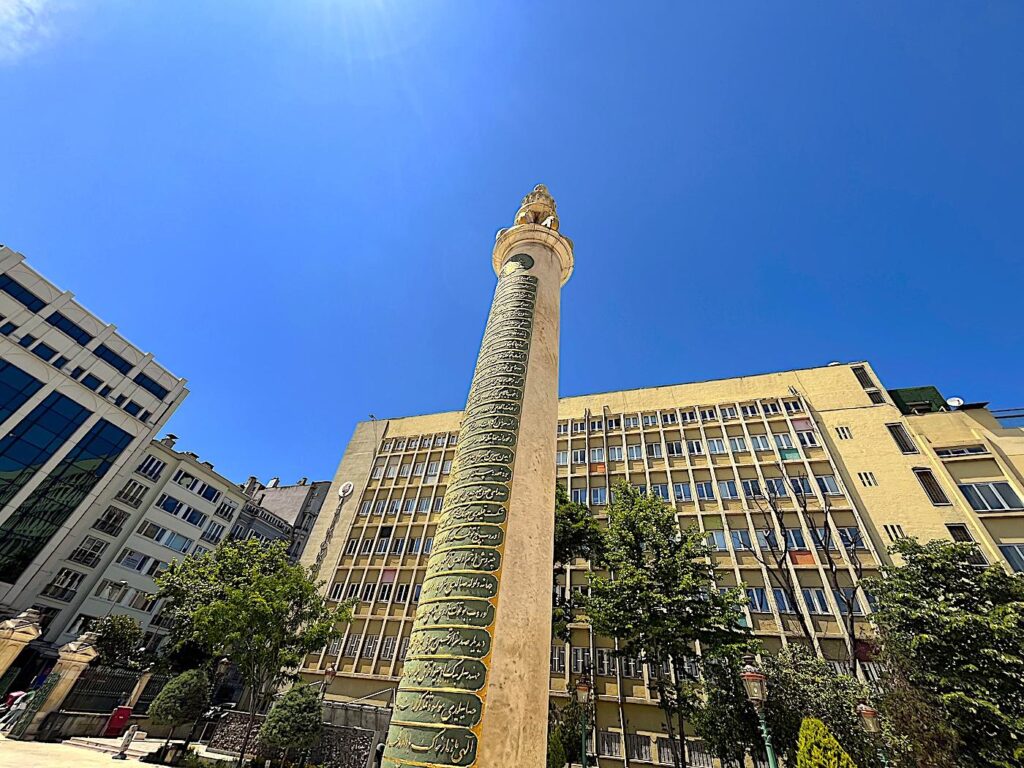
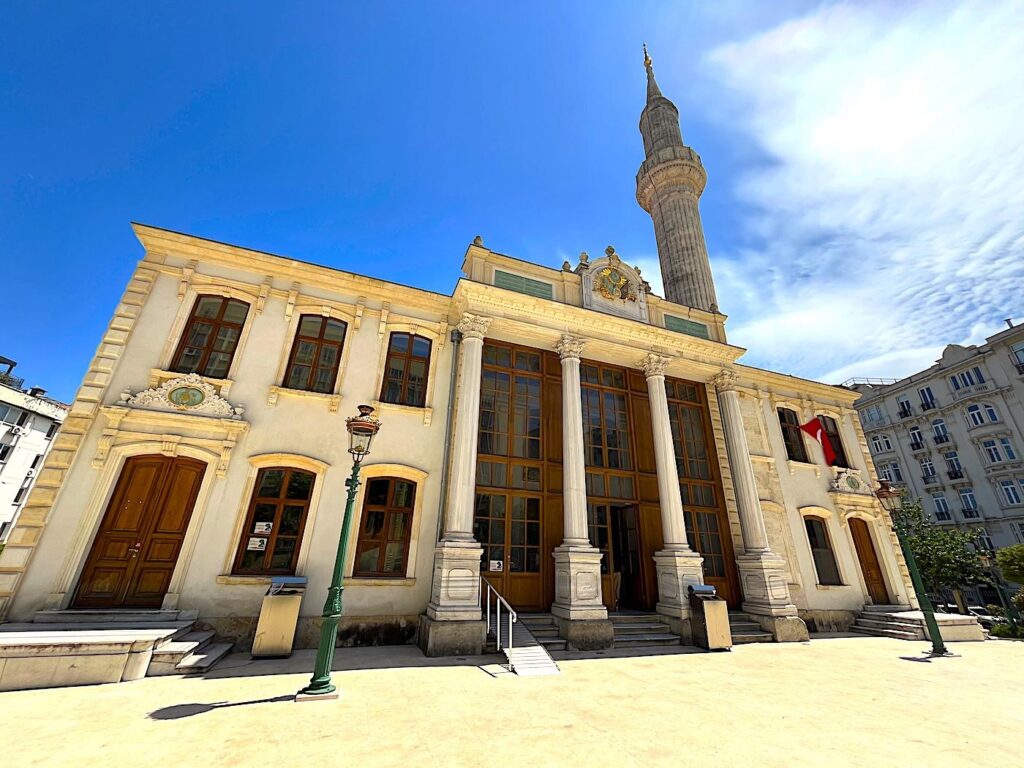
Architecturally, the Teşvikiye Mosque is a distinguished example of the Ottoman revivalist style, featuring strong Neoclassical and Empire-era design elements. Its elegant façade features tall arched windows, Corinthian-style pilasters, and finely carved stone ornamentation. The mosque has a single minaret and a relatively modest dome, but its grandeur lies in its symmetry and refined details. Unusually for a mosque, its inscription is in Ottoman Turkish using the Latin alphabet added during the early Republican period, symbolising the modernist shift in Turkey. The interior is airy and bright, featuring large windows and minimal decoration, which contrasts with the more elaborate designs of earlier Ottoman mosques, reflecting Western architectural sensibilities.
In front of the mosque stands a large marble column, known as the Nişan Taşı (Target Stone), a relic from Ottoman times used to commemorate imperial archery feats. These stones recorded the distance of arrows shot by the sultan or other prominent figures, symbolising strength and skill. Teşvikiye Mosque has become widely known in modern times as the site of funerals and memorial ceremonies for Turkish cultural icons, artists, politicians, and celebrities. Its location in one of Istanbul’s most prestigious neighbourhoods, its proximity to media outlets and cultural institutions, and its elegant yet accessible character all contribute to its prominence.
Ferruh Kethüda Mosque (1563)
Location: Ferruh Kethüda Camii, Ayvansaray, Ferruh Kahya Sk. No:11, 34087 Fatih/İstanbul. No known official website. Opening Hours: Daily: As a working mosque, there are no set hours. Entrance Fee: Entry to the mosque is free.
The Ferruh Kethüda Mosque, located in Istanbul’s Ayvansaray neighborhood, was commissioned in 1562-1563 by Ferruh Ağa, the steward (kethüda) of Grand Vizier Semiz Ali Paşa during Sultan Suleiman the Magnificent’s reign. Designed by the renowned Ottoman architect Mimar Sinan, the mosque was part of a larger complex that included a dervish lodge (tekke), a courthouse, and a fountain, reflecting its multifunctional role in the community. When the Tekkes closed in the late 19th century due to fires, the mosque was decommissioned and fell into a state of ruin. In 1953, an association established by the local community renovated the mosque and reopened it for worship in 1960; further repairs were also made in 1986 and between 2016 and 2021.

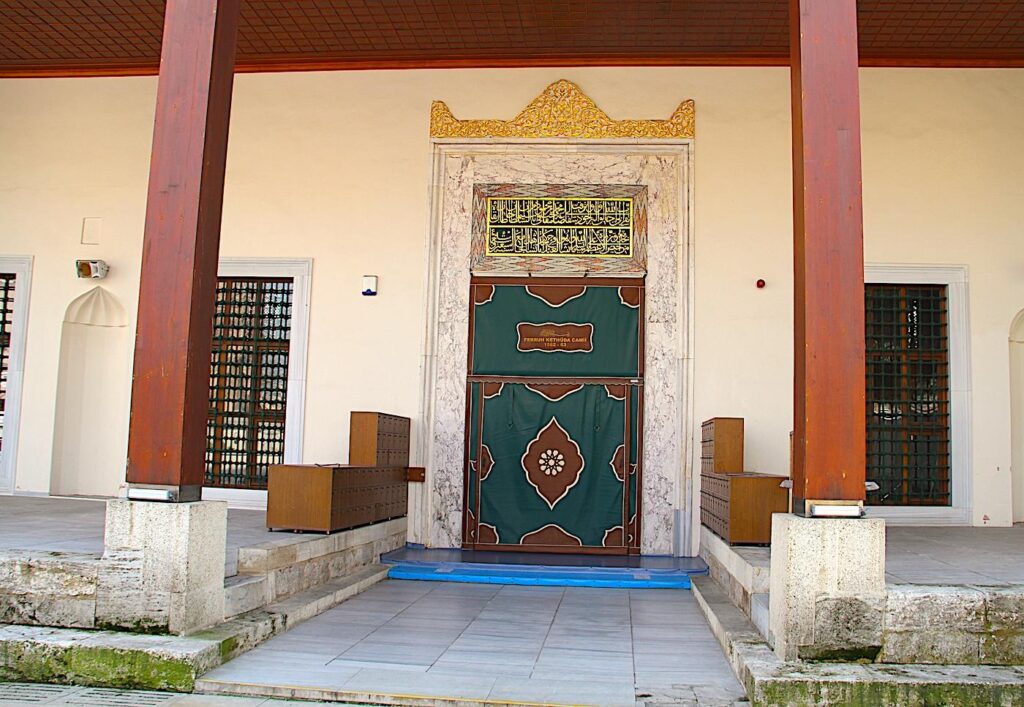
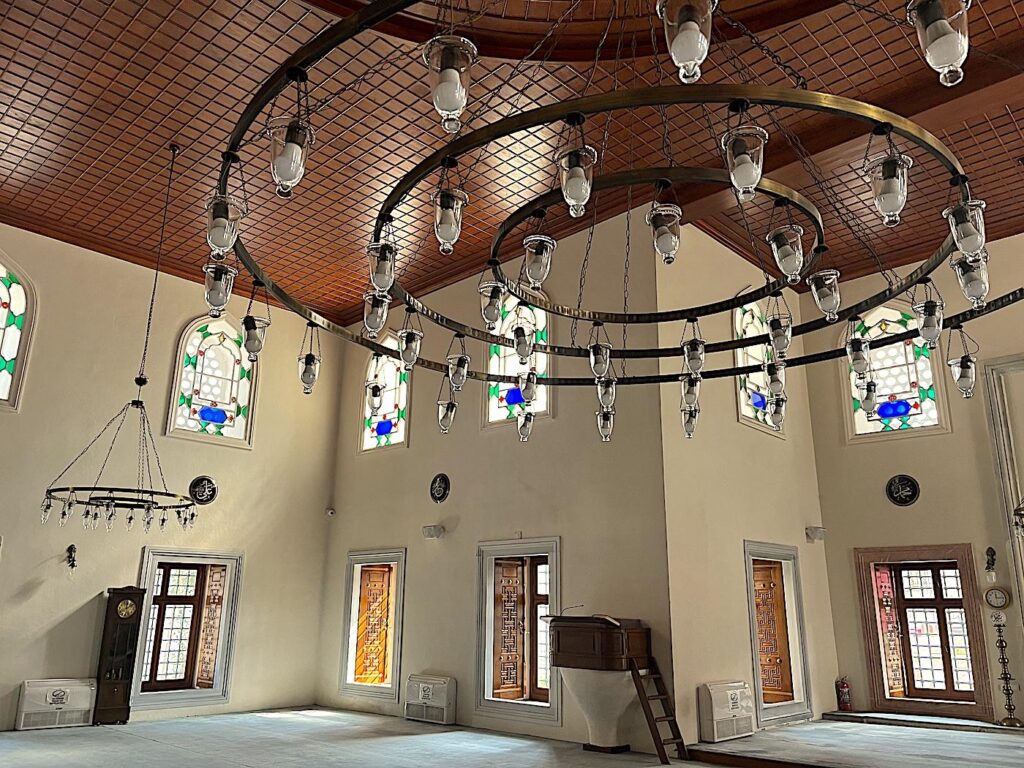
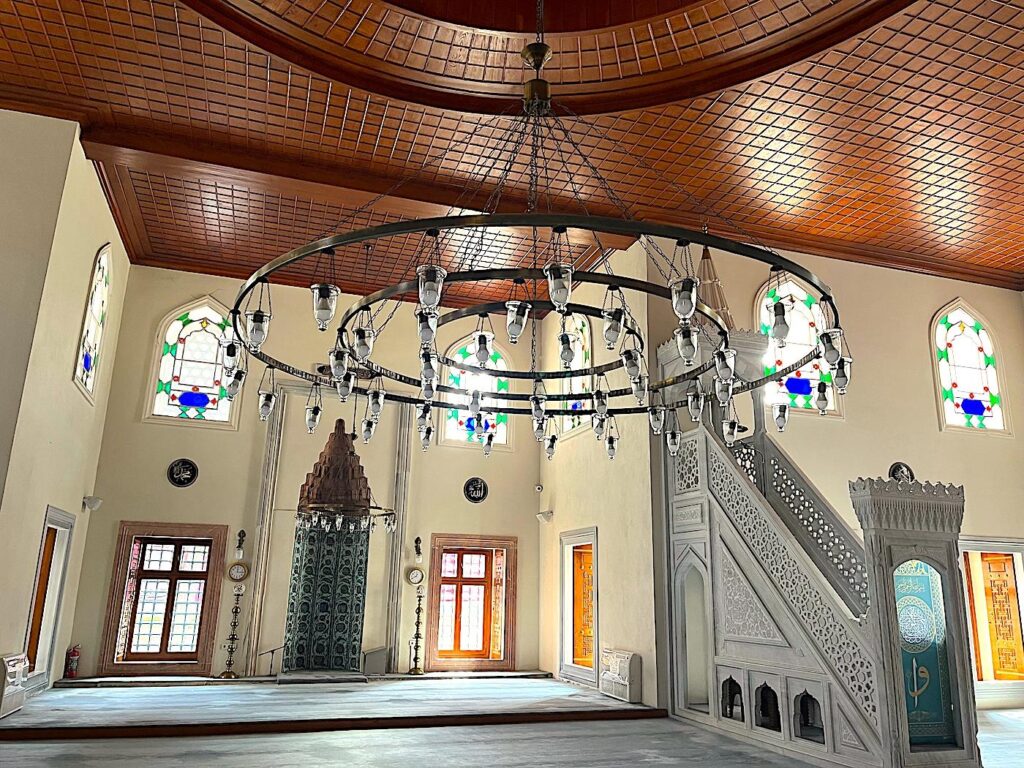
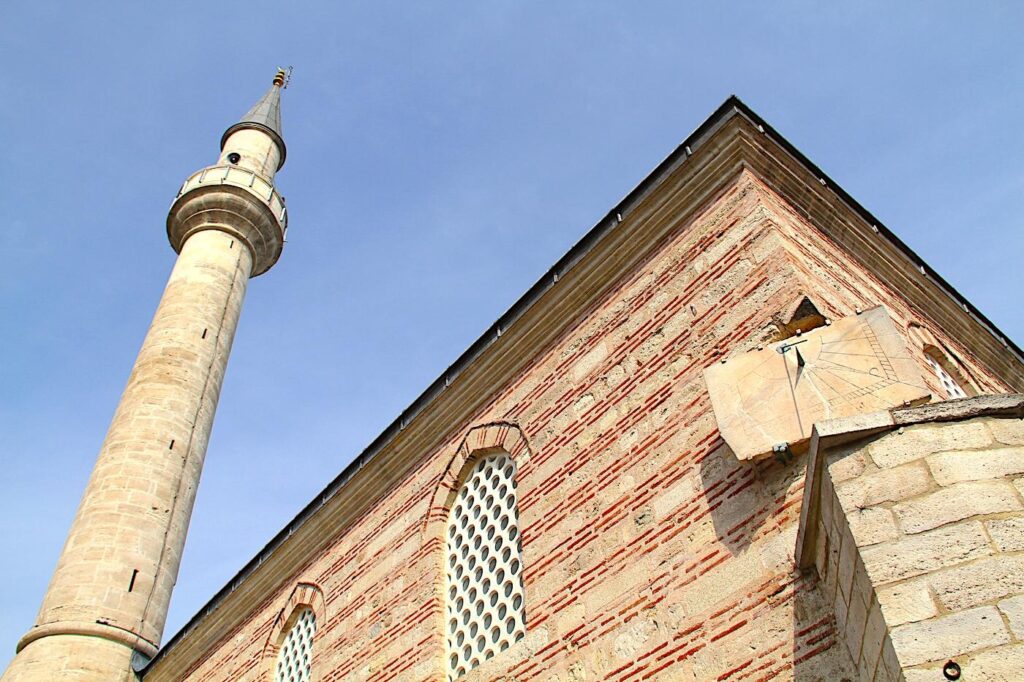
A distinctive feature of the mosque is its mihrab, adorned with tiles produced in the early 18th century at the Tekfur Palace tile workshops. Unlike many of Sinan’s other mosque designs, the Ferruh Kethüda Mosque features a wooden roof with an internal dome that is not visible from the exterior. The mosque also houses a sundial on its qibla wall and an ornamental pool in its courtyard, adding to its unique architectural elements.
Taksim Mosque (2021)
Location: Taksim Camii Kültür ve Sanat Merkezi, Gümüşsuyu, Taksim Cd. 2 B, 34437 Beyoğlu/İstanbul. Official website. Opening Hours: Daily: The mosque opens one hour before the morning call to prayer (adhan) and closes at midnight. Entrance Fee: Entry to the mosque is free.
The Taksim Mosque (Taksim Camii) is a relatively recent addition to Istanbul’s skyline, located in the prominent Taksim Square. Its construction was a topic of much discourse and planning over many years. The mosque was designed by architects Şefik Birkiye and Selim Dalaman, and it was officially opened for worship on May 28, 2021, with a ceremony attended by President Recep Tayyip Erdoğan. Construction began on February 17, 2017, and was completed in approximately four years.



Architecturally, the Taksim Mosque blends modern and traditional Ottoman influences, incorporating elements of Art Deco style into its design. It includes a large central dome and two minarets, creating a noticeable presence in Taksim Square. The mosque complex also includes various facilities, such as a library, exhibition hall, and parking garage, aiming to serve as a cultural and social centre.
Grand Çamlıca Mosque (2019)
Location: Büyük Çamlıca Camii, Ferah, Ferah Yolu Sk. No:6 D:3, 34692 Üsküdar/İstanbul. Official website (Turkish). Opening Hours: Daily: As a working mosque, there are no set opening hours. Entrance Fee: Entry to the mosque is free.
The Grand Çamlıca Mosque, the largest mosque in Türkiye, is a prominent and relatively new landmark in Istanbul. Completed and opened in 2019, it stands atop Çamlıca Hill, offering panoramic city views. The mosque was designed by architects Bahar Mızrak and Hayriye Gül Totu and represents a blend of classical Ottoman and contemporary architectural styles. It was built to create a prominent, central place of worship capable of accommodating 63,000 worshippers and serving as a cultural complex, making it significantly more extensive than many of Istanbul’s historic mosques. The Çamlıca Mosque includes an 11,000 square metre museum, a 3,500 square metre art gallery, a library of 3,000 square metres, a 1,000 capacity conference hall, eight art workshops, and indoor parking for 3,500 vehicles.
Architecturally, the Grand Çamlıca Mosque is distinguished by its impressive scale and intricate detailing. It features six minarets, a large central dome, and numerous smaller domes, creating a visually striking silhouette. The complex also includes a library, art gallery, conference hall, and other facilities, demonstrating its role as a multifaceted cultural centre. The design incorporates symbolic elements, such as the height of the minaret; four of the mosque’s six minarets stand at a height of 107.1 meters. This measurement is a deliberate reference to the Battle of Manzikert, a pivotal victory for the Seljuk Turks over the Byzantine Empire in 1071. The mosque’s central dome, which is 72 metres high, symbolises the 72 nations living in Istanbul, and its 34-meter-diameter dome symbolises Istanbul (number used on motor vehicle plates). The mosque’s interior is designed to foster a spiritual atmosphere, with careful consideration given to lighting, colours, and calligraphic art.
Yeralti Mosque (1756)
Location: Yeraltı Camii, Kemankeş Karamustafa Paşa, Kemankeş Cd. No:23, 34425 Beyoğlu/İstanbul. Official website (Turkish). Opening Hours: Daily: As a working mosque, there are no set opening hours. Entrance Fee: Entry to the mosque is free.
The Yeraltı Mosque, also known as the “Underground Mosque,” is a unique and atmospheric place of worship situated in Istanbul’s Karaköy district, near the Galata Bridge. Its origins date back to the 18th century. However, its structure is believed to be much older, possibly dating to the Byzantine or Genoese period, when the area was part of the Galata district, fortified by walls. The mosque was built over an existing vaulted substructure that had previously served as a military storage area or dungeon. Over time, the structure was converted into a place of prayer, particularly associated with the veneration of two Muslim warriors, Amr bin As and Sufyan bin Uyeyne, who were believed to have died during the first Arab sieges of Constantinople in the 7th century. Their symbolic tombs are located within the mosque, contributing to its spiritual and historical significance.


Architecturally, the Yeraltı Mosque is strikingly different from traditional Ottoman mosques. It lacks minarets and domes, instead resembling a crypt, with a low, barrel-vaulted ceiling supported by thick stone pillars. The interior is dimly lit, with an austere, cave-like ambience that reinforces its subterranean character. Its “underground” nature is mainly because the structure was repurposed rather than newly constructed above ground. Urban development and centuries of sediment accumulation around the Galata shoreline also contributed to its appearance below street level. Despite its small size and unusual form, the mosque holds deep religious meaning for local Muslims and visitors drawn to its mysterious atmosphere and early Islamic associations.
Grand Architect Mimar Sinan
Mimar Sinan, born in Ağırnas near Kayseri in 1490, was the chief Ottoman architect for sultans Suleiman the Magnificent, Selim II, and Murad III. He died in Istanbul in 1588. While it’s difficult to give an exact number, Sinan is credited with designing or supervising the construction of hundreds of structures, including mosques, schools, bridges, and other public works. Estimates of his mosque construction range widely, but he is known to have created well over 100 mosques, and his body of work is considered to be over 400 structures in total.
He was a titan of architectural history, and his prolific career saw the construction of hundreds of structures, with his mosques in Istanbul forming the core of his enduring legacy. Sinan’s mastery of spatial design, structural engineering, and aesthetic harmony revolutionized Ottoman architecture. He perfected the central-domed mosque design, creating vast, luminous interiors that fostered profound spiritual tranquillity. His Süleymaniye Mosque, Şehzade Mosque, and numerous other Istanbul mosques showcase his innovative use of pendentives, half-domes, and intricate tilework, establishing a new standard for mosque architecture. His meticulous attention to detail and ability to integrate buildings seamlessly into the urban fabric cemented his reputation as a master builder.
| Mosque | Location | Construction |
|---|---|---|
| Early Period | ||
| Haseki Sultan Mosque (Haseki Hürrem Sultan Camii) | Cerrahpaşa, Fatih | 1538 – 1540 |
| Shehzade Mosque (Şehzade Camii) | Kalenderhane, Fatih | 1543 – 1548 |
| Mihrimah Sultan Mosque (Mihrimah Sultan Camii) Üsküdar | Mimar Sinan, Üsküdar | 1543 – 1548 |
| Middle Period | ||
| Süleymaniye Mosque (Süleymaniye Camii) | Süleymaniye, Fatih | 1550 – 1557 |
| Sinan Pasha Mosque (Sinan Paşa Camii) | Sinanpaşa, Beşiktaş | 1554 – 1556 |
| Rüstem Pasha Mosque (Rüstem Paşa Camii) | Rüstem Paşa, Fatih | 1561 – 1563 |
| Ferruh Kethüda Mosque (Ferruh Kethüda Camii) | Ayvansaray, Fatih | 1562 – 1563 |
| Late Period | ||
| Mihrimah Sultan Mosque (Mihrimah Sultan Camii) Edirnekapı | Karagümrük, Fatih | 1563 – 1566 |
| Kılıç Ali Pasha Mosque (Kılıç Ali Paşa Camii) | Kılıçali Paşa, Beyoğlu | 1578 – 1587 |
Sinan’s impact extended far beyond individual mosques, profoundly shaping the cityscape of Istanbul. He designed entire complexes, including schools, hospitals, and charitable institutions, creating integrated urban spaces that served the population’s diverse needs. His influence is visible in the city’s skyline, dominated by the elegant silhouettes of his minarets and domes. He built structures and shaped the essence of Ottoman urban planning, leaving an indelible mark on Istanbul’s architectural identity. By prioritising functionality, durability, and aesthetic beauty, Mimar Sinan transformed Istanbul into a city of architectural splendour, a legacy that inspires awe and admiration.
General Information on Visiting Istanbul Mosques
Etiquette for Tourists Entering a Mosque
When visiting a mosque in Türkiye, it’s essential to demonstrate respect for the Islamic faith and the sacred space. Modesty is paramount in dress: men and women should wear loose-fitting clothing covering arms and legs, and women must cover their hair with a headscarf, which is often provided at the entrance. Shoes are always removed before entering the prayer area, and visitors should maintain a quiet and respectful demeanour, avoiding loud conversations or disruptive behaviour. Photography policies vary, so it’s crucial to check for restrictions and avoid photographing worshippers without permission, especially during prayer times.

Prayer times are particularly significant, and tourists should avoid visiting during these periods if possible. If present during prayer, observe quietly from a respectful distance, never walking in front of those praying. It’s essential to silence mobile phones and refrain from eating, drinking, or smoking within the mosque. Treat the mosque as a place of worship, adhering to any instructions given by mosque staff or volunteers. Understanding the historical and cultural significance of the mosque beforehand will enhance your visit and show a deeper appreciation for the site.
Finally, while entry to many mosques is free, donations are appreciated and contribute to maintaining these important cultural and religious sites. Showing general respect for the space, the worshippers, and the customs is crucial. If you have questions, approach mosque staff or worshippers respectfully. By adhering to these guidelines, tourists can ensure a positive and enriching experience while demonstrating their respect for Islamic culture in Türkiye.
Mosque Prayer Times
Prayer times in Türkiye, as in all Muslim-majority regions, are determined by the sun’s position. There are five daily prayers: Fajr (dawn), Dhuhr (noon), Asr (afternoon), Maghrib (sunset), and Isha (night). These times vary throughout the year depending on the location and the season, as the length of daylight changes. Therefore, it’s essential to consult a reliable source for up-to-date prayer times.
Prayer times shift daily, so relying on a source that provides daily updates is crucial. When planning a visit to a mosque, it is best to avoid prayer times so as not to interrupt those who are there to worship. The Religious Affairs Directorate (Diyanet) provides official prayer times for all regions of Türkiye. Their website details accurate prayer times, including a clock countdown to the following prayers, the angle of Qibla (in Istanbul 29° east of south) and astronomic sunrise and sunset times.
See also – LikeTurkiye.com – Best of Istanbul Top 10 Historical Sites
